

High School Essay
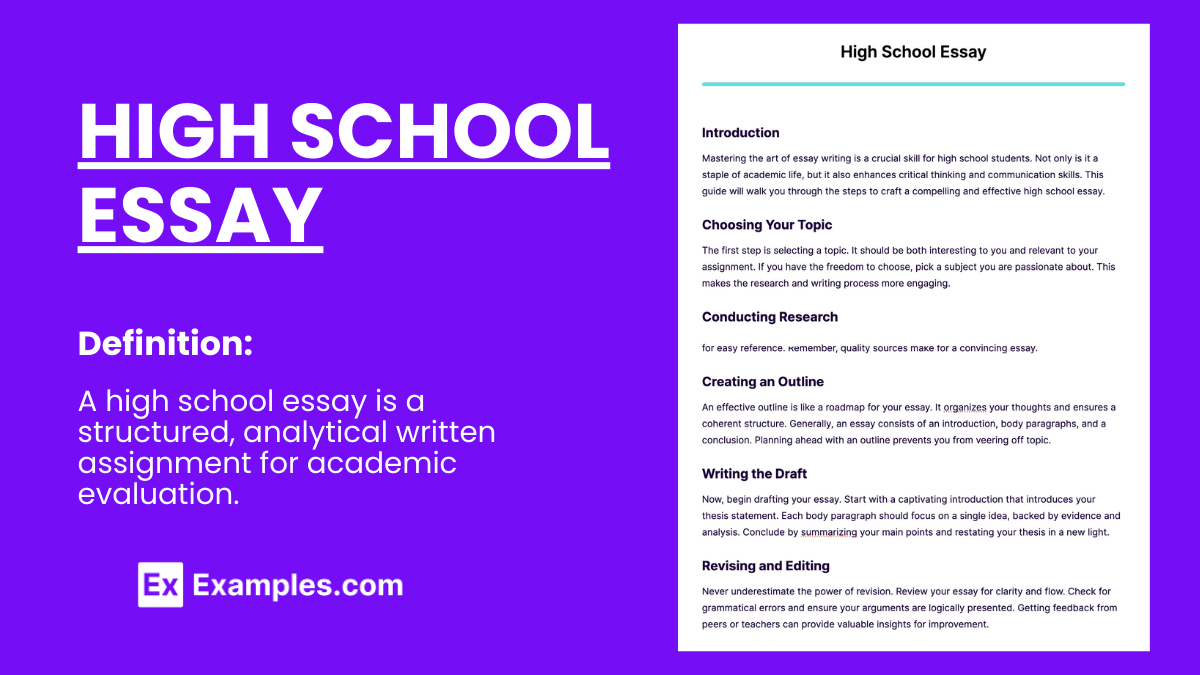
Navigating the complexities of High School Essay writing can be a challenging yet rewarding experience. Our guide, infused with diverse essay examples , is designed to simplify this journey for students. High school essays are a crucial part of academic development, allowing students to express their thoughts, arguments, and creativity. With our examples, students learn to structure their essays effectively, develop strong thesis statements, and convey their ideas with clarity and confidence, paving the way for academic success.
What Is a High School Essay? A high school essay is anything that falls between a literary piece that teachers would ask their students to write. It could be anything like an expository essay , informative essay , or a descriptive essay . High school essay is just a broad term that is used to describe anything that high school student writes, probably in subjects like English Grammar or Literature.
It is a good way to practice every student’s writing skills in writing which they might find useful when they reach college. Others might even be inspired to continue writing and take courses that are related to it.
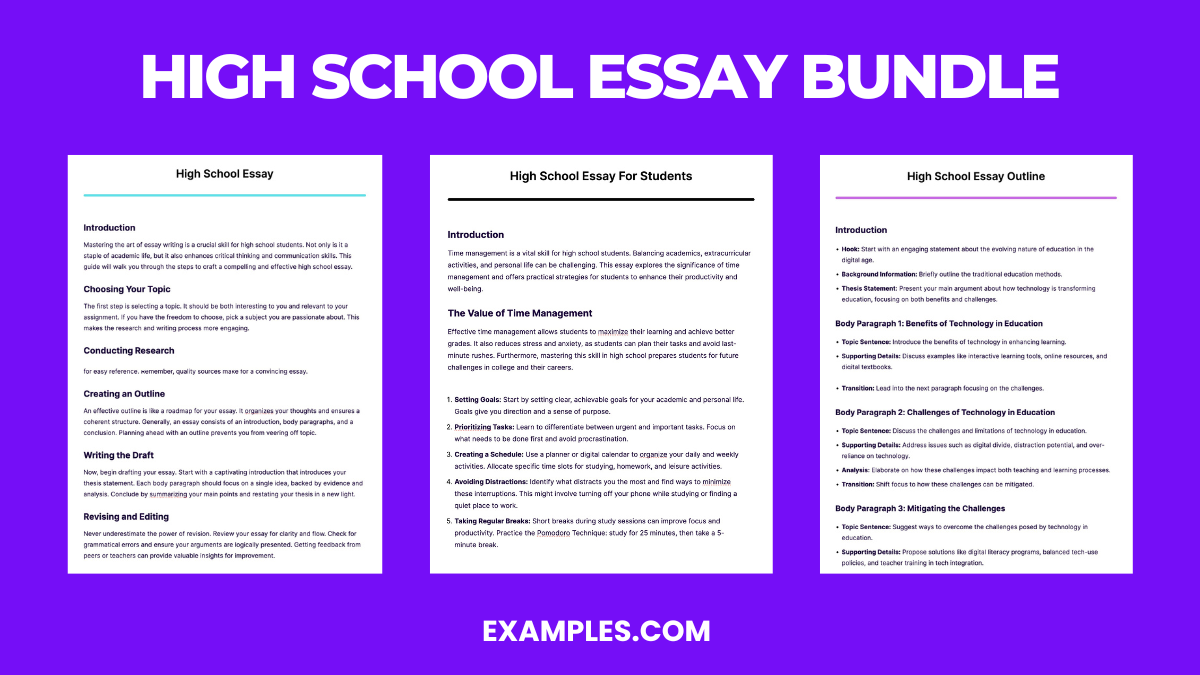
Download High School Essay Bundle
When you are in high school, it is definite that you are expected to do some write-ups and projects which require pen and paper. Yes. You heard that right. Your teachers are going to let you write a lot of things starting from short stories to other things like expository essays. However, do not be intimidated nor fear the things that I have just said. It is but a normal part of being a student to write things. Well, take it from me. As far as I can recall, I may have written about a hundred essays during my entire high school years or maybe more. You may also see what are the parts of an essay?
High School Essay Format
1. introduction.
Hook: Start with an engaging sentence to capture the reader’s interest. This could be a question, a quote, a surprising fact, or a bold statement related to your topic. Background Information: Provide some background information on your topic to help readers understand the context of your essay. Thesis Statement: End the introduction with a clear thesis statement that outlines your main argument or point of view. This statement guides the direction of your entire essay.
2. Body Paragraphs
Topic Sentence: Start each body paragraph with a topic sentence that introduces the main idea of the paragraph, supporting your thesis statement. Supporting Details: Include evidence, examples, facts, and quotes to support the main idea of each paragraph. Make sure to explain how these details relate to your topic sentence and thesis statement. Analysis: Provide your analysis or interpretation of the evidence and how it supports your argument. Be clear and concise in explaining your reasoning. Transition: Use transition words or phrases to smoothly move from one idea to the next, maintaining the flow of your essay.
3. Conclusion
Summary: Begin your conclusion by restating your thesis in a new way, summarizing the main points of your body paragraphs without introducing new information. Final Thoughts: End your essay with a strong closing statement. This could be a reflection on the significance of your argument, a call to action, or a rhetorical question to leave the reader thinking.
Example of High School Essay
Community service plays a pivotal role in fostering empathy, building character, and enhancing societal well-being. It offers a platform for young individuals to contribute positively to society while gaining valuable life experiences. This essay explores the significance of community service and its impact on both individuals and communities. Introduction Community service, an altruistic activity performed for the betterment of society, is a cornerstone for personal growth and societal improvement. It not only addresses societal needs but also cultivates essential virtues in volunteers. Through community service, high school students can develop a sense of responsibility, a commitment to altruism, and an understanding of their role in the community. Personal Development Firstly, community service significantly contributes to personal development. Volunteering helps students acquire new skills, such as teamwork, communication, and problem-solving. For instance, organizing a local food drive can teach students project management skills and the importance of collaboration. Moreover, community service provides insights into one’s passions and career interests, guiding them towards fulfilling future endeavors. Social Impact Secondly, the social impact of community service cannot be overstated. Activities like tutoring underprivileged children or participating in environmental clean-ups address critical societal issues directly. These actions not only bring about immediate positive changes but also inspire a ripple effect, encouraging a culture of volunteerism within the community. The collective effort of volunteers can transform neighborhoods, making them more supportive and resilient against challenges. Building Empathy and Understanding Furthermore, community service is instrumental in building empathy and understanding. Engaging with diverse groups and working towards a common goal fosters a sense of solidarity and compassion among volunteers. For example, spending time at a senior center can bridge the generational gap, enriching the lives of both the elderly and the volunteers. These experiences teach students the value of empathy, enriching their emotional intelligence and social awareness. In conclusion, community service is a vital component of societal development and personal growth. It offers a unique opportunity for students to engage with their communities, learn valuable life skills, and develop empathy. Schools and parents should encourage students to participate in community service, highlighting its benefits not only to the community but also in shaping responsible, caring, and informed citizens. As we look towards building a better future, the role of community service in education cannot be overlooked; it is an investment in our collective well-being and the development of the next generation.
Essay Topics for High School with Samples to Edit & Download
- Should schools have dress codes?
- Sex education in middle school
- Should homework be abolished?
- College education costs
- How does technology affect productivity?
- Is climate change reversible?
- Is social media helpful or harmful?
- Climate change is caused by humans
- Effects of social media on youth
- Are men and women treated equally?
- Are professional athletes overpaid?
- Changes over the past decade
- Guns should be more strictly regulated
- My favorite childhood memory
- Religion in school
- Should we stop giving final exams?
- Video game addiction
- Violence in media content
High School Essay Examples & Templates
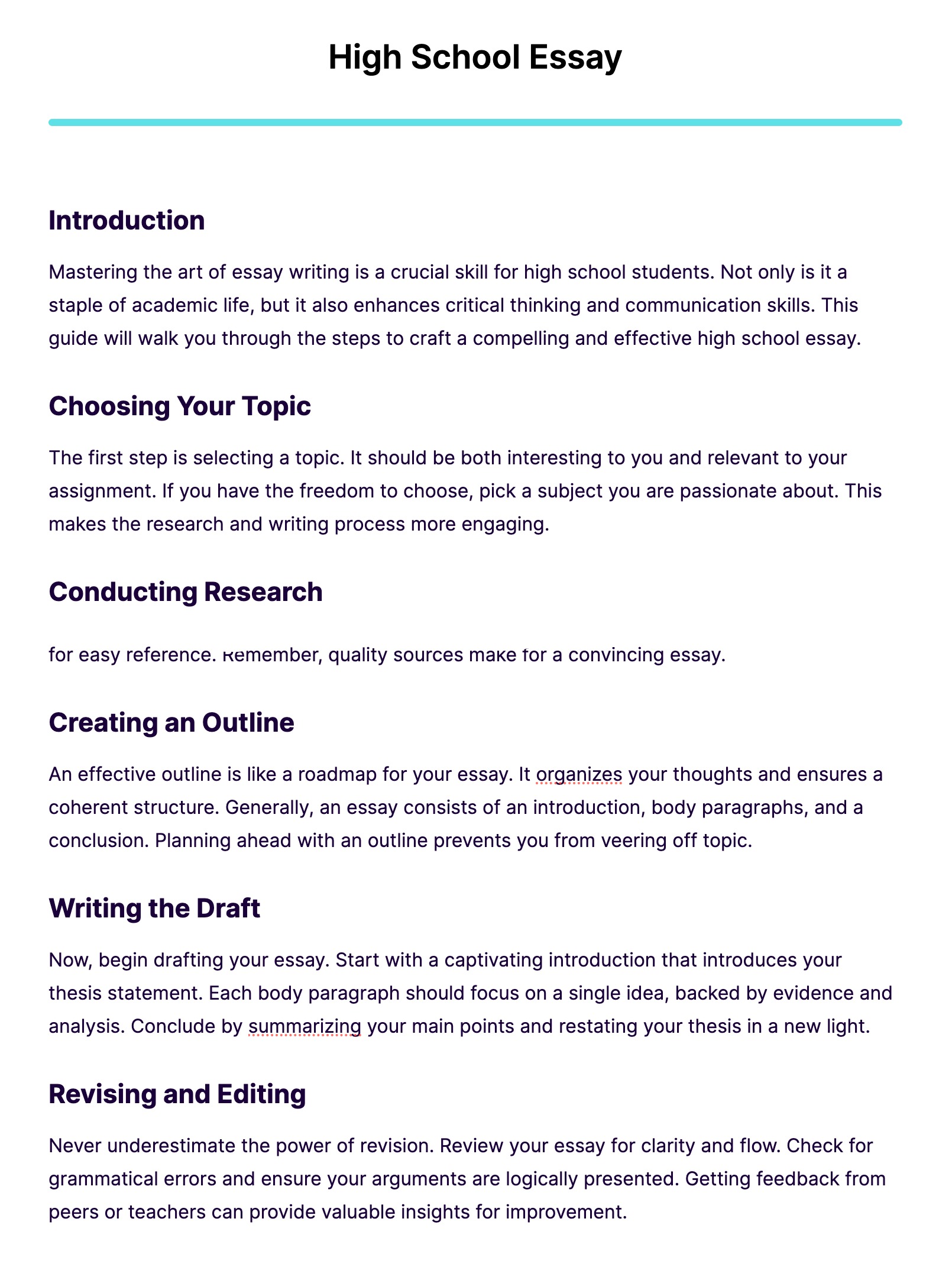
Free Download
High School Essay For Students
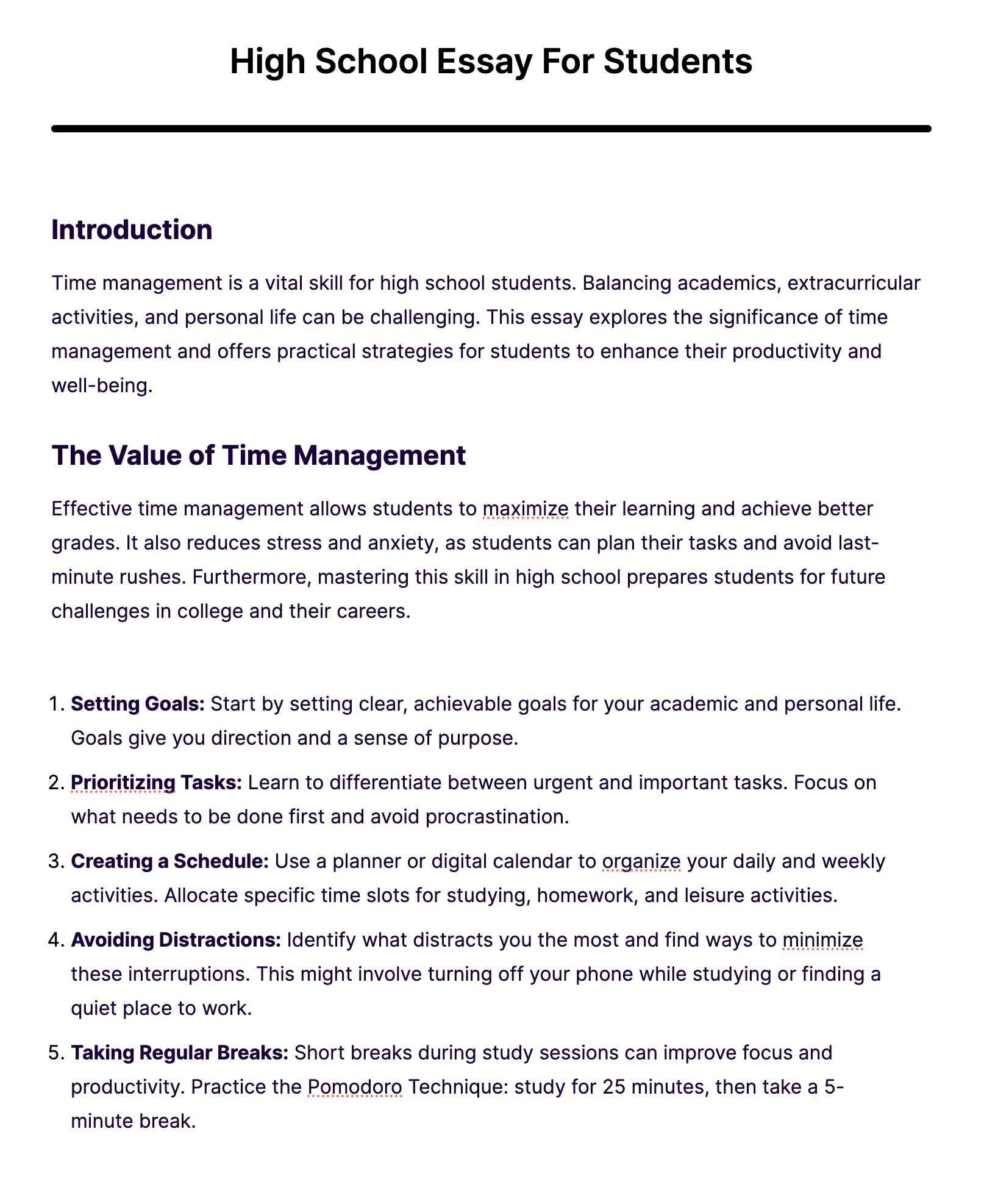
High School Essay Outline
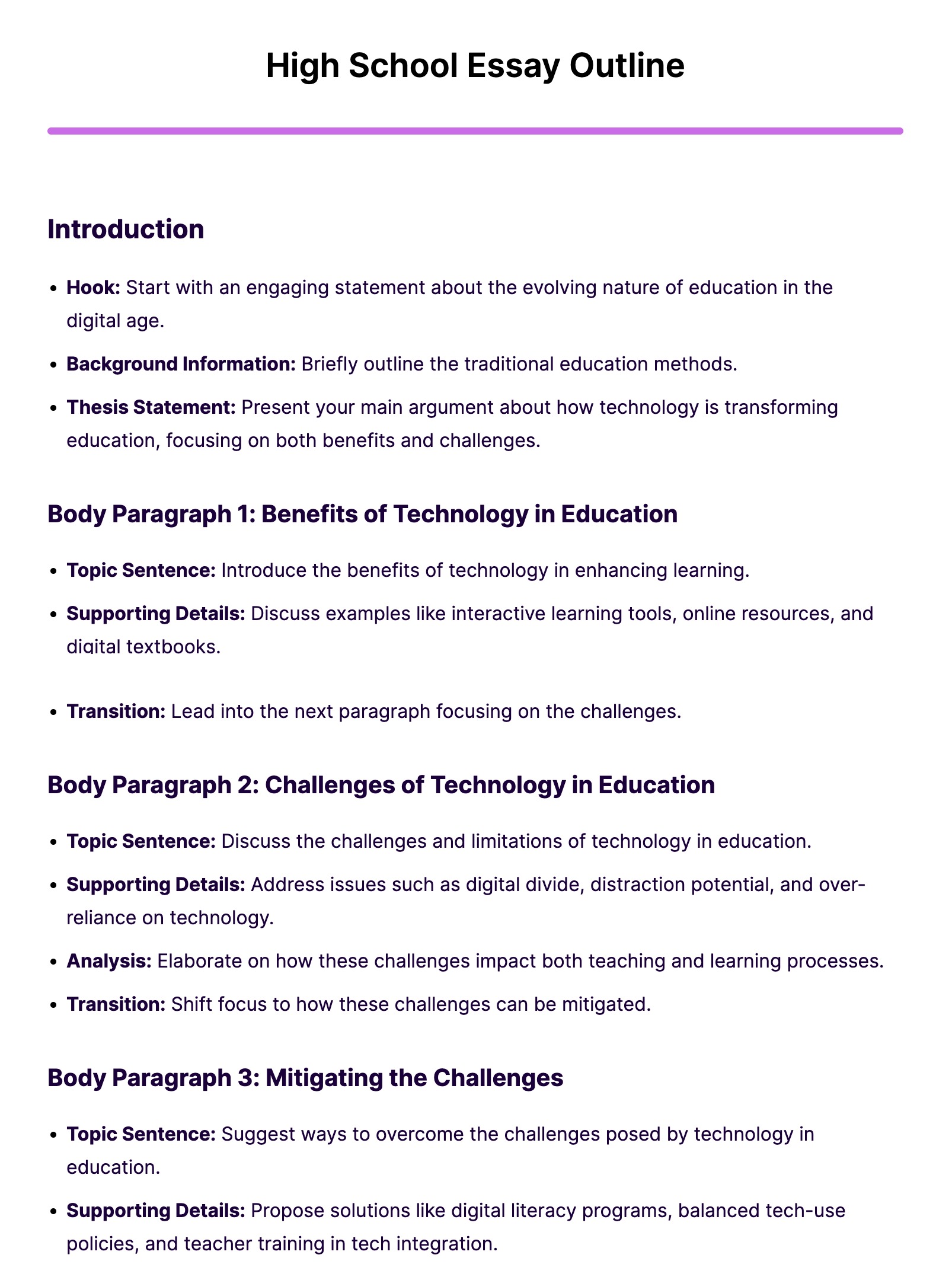
High School Essay Example
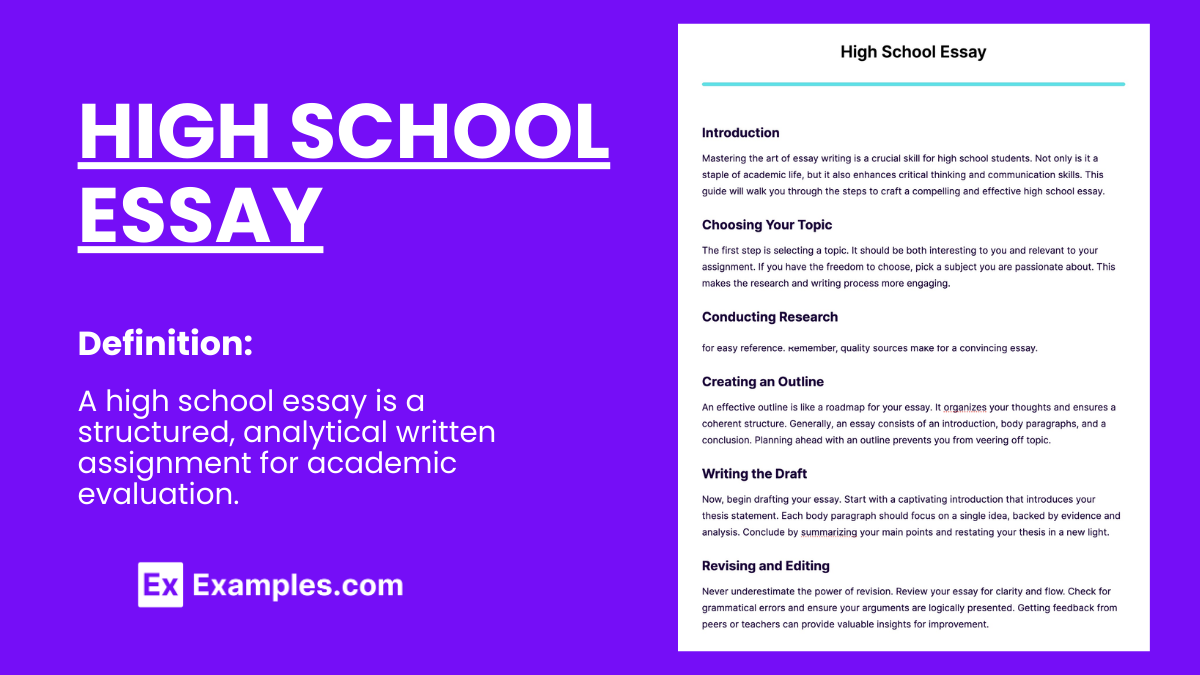
High School Self Introduction Essay Template
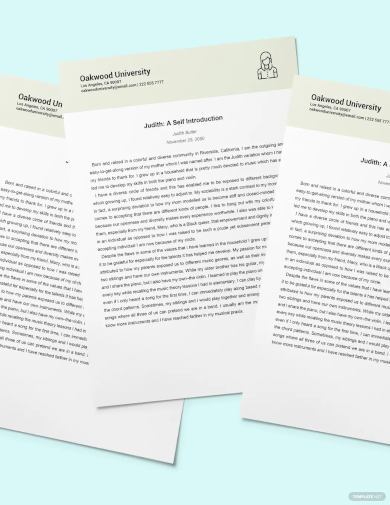
High School Student Essay
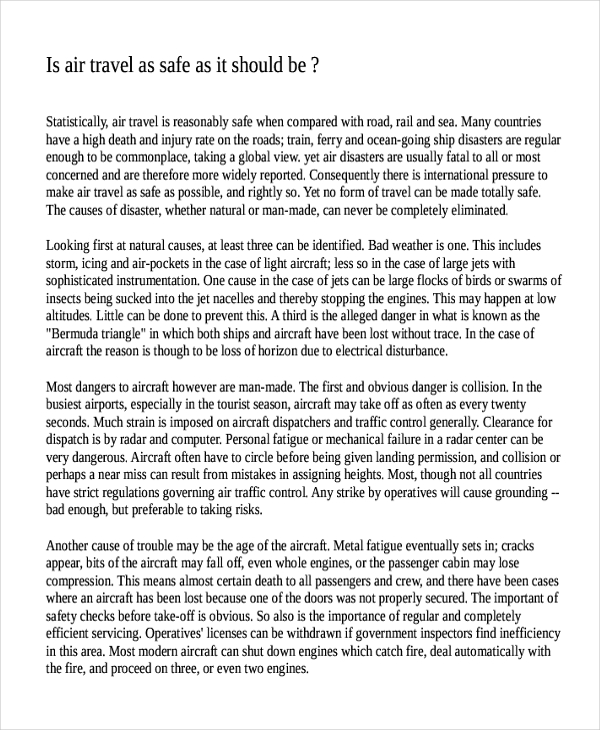
englishdaily626.com
Reflective High School
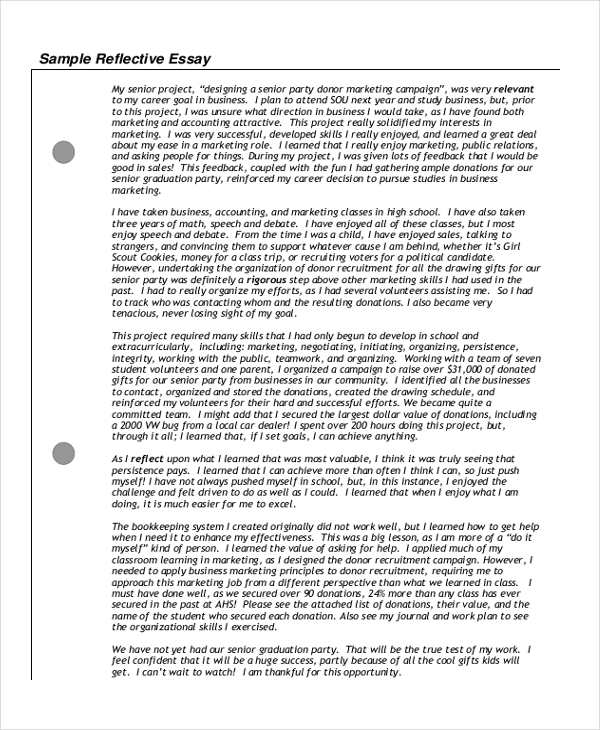
oregoncis.uoregon.edu
Argumentative Essays for High School
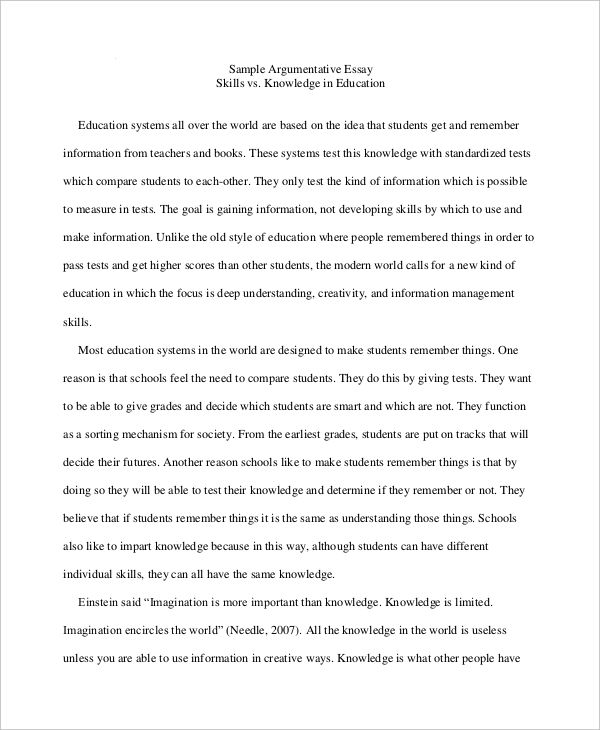
Informative Essays for High School
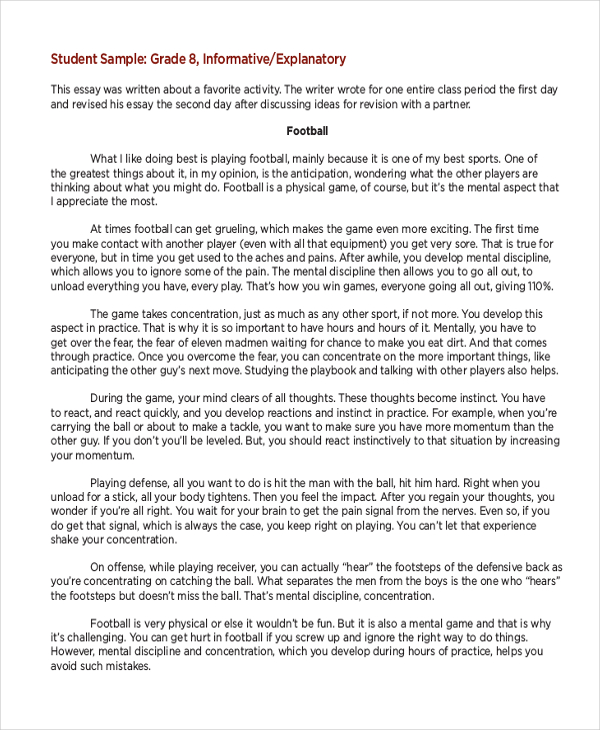
High School Persuasive
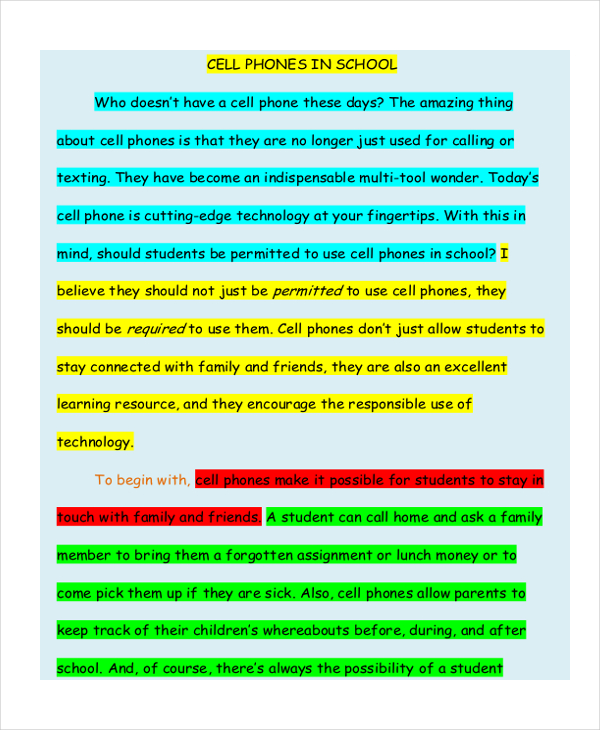
writecook.com
Narrative Essays
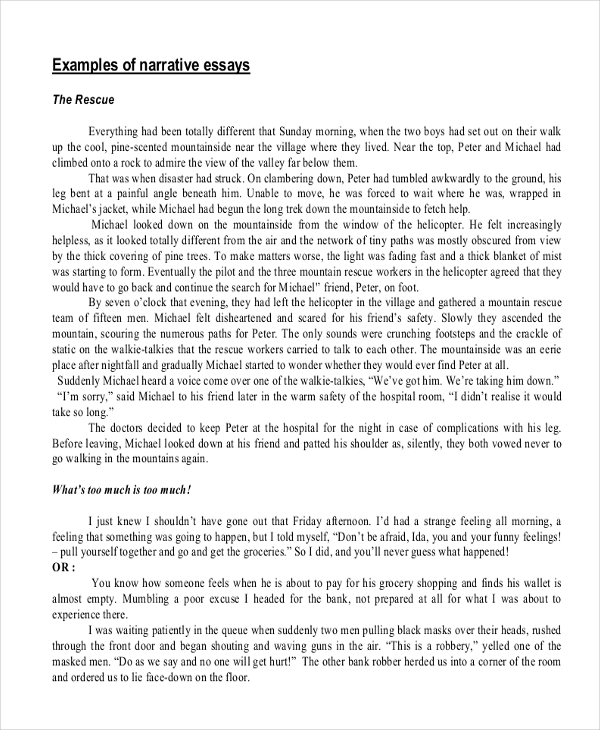
Scholarship Essays

High School Application
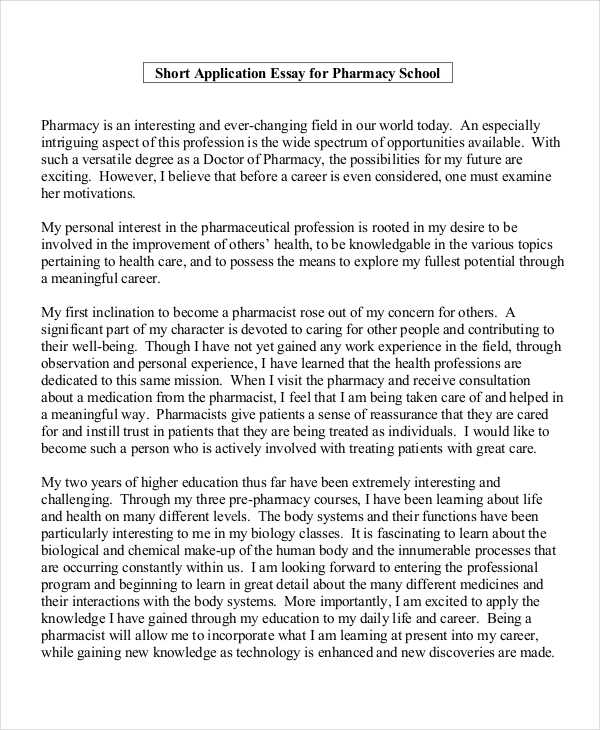
e-education.psu.edu
High School Graduation Essay
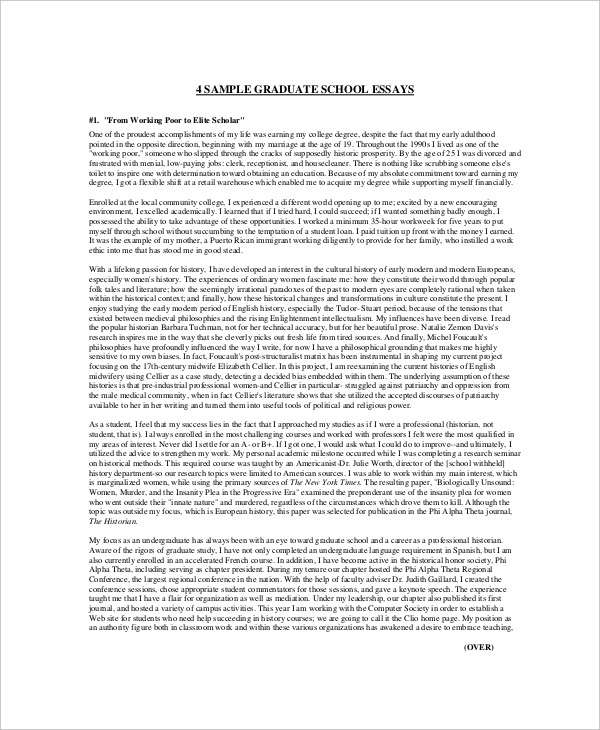
High School Leadership Essay
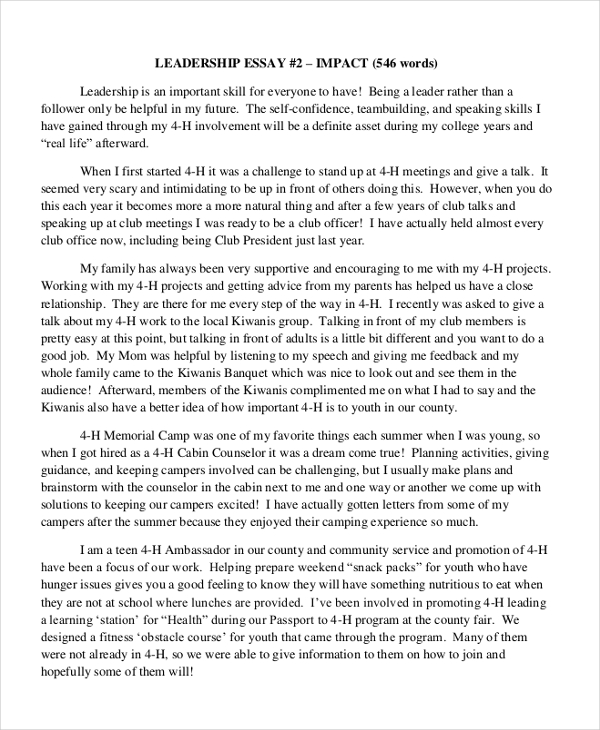
web.extension.illinois.edu
How to Write a High School Essay
Some teachers are really not that strict when it comes to writing essay because they too understand the struggles of writing stuff like these. However, you need to know the basics when it comes to writing a high school essay.
1. Understand the Essay Prompt
- Carefully read the essay prompt or question to understand what’s required. Identify the type of essay (narrative, persuasive, expository, etc.) and the main topic you need to address.
2. Choose a Topic
- If the topic isn’t provided, pick one that interests you and fits the essay’s requirements. Make sure it’s neither too broad nor too narrow.
3. Conduct Research (if necessary)
- For expository, argumentative, or research essays, gather information from credible sources to support your arguments. Take notes and organize your findings.
4. Create an Outline
- Outline your essay to organize your thoughts and structure your arguments effectively. Include an introduction, body paragraphs, and a conclusion.
5. Write the Introduction
- Start with a hook to grab the reader’s attention (a quote, a question, a shocking fact, etc.). Introduce your topic and end the introduction with a thesis statement that presents your main argument or purpose.
6. Develop Body Paragraphs
- Each body paragraph should focus on a single idea or argument that supports your thesis. Start with a topic sentence, provide evidence or examples, and explain how it relates to your thesis.
7. Write the Conclusion
- Summarize the main points of your essay and restate your thesis in a new way. Conclude with a strong statement that leaves a lasting impression on the reader.
Types of High School Essay
1. narrative essay.
Narrative essays tell a story from the writer’s perspective, often highlighting a personal experience or event. The focus is on storytelling, including characters, a setting, and a plot, to engage readers emotionally. This type allows students to explore creativity and expressiveness in their writing.
2. Descriptive Essay
Descriptive essays focus on detailing and describing a person, place, object, or event. The aim is to paint a vivid picture in the reader’s mind using sensory details. These essays test the writer’s ability to use language creatively to evoke emotions and bring a scene to life.
3. Expository Essay
Expository essays aim to explain or inform the reader about a topic in a clear, concise manner. This type of essay requires thorough research and focuses on factual information. It’s divided into several types, such as compare and contrast, cause and effect, and process essays, each serving a specific purpose.
4. Persuasive Essay
Persuasive essays aim to convince the reader of a particular viewpoint or argument. The writer must use logic, reasoning, and evidence to support their position while addressing counterarguments. This type tests the writer’s ability to persuade and argue effectively.
5. Analytical Essay
Analytical essays require the writer to break down and analyze an element, such as a piece of literature, a movie, or a historical event. The goal is to interpret and make sense of the subject, discussing its significance and how it achieves its purpose.
6. Reflective Essay
Reflective essays are personal pieces that ask the writer to reflect on their experiences, thoughts, or feelings regarding a specific topic or experience. It encourages introspection and personal growth by examining one’s responses and learning from them.
7. Argumentative Essay
Similar to persuasive essays, argumentative essays require the writer to take a stance on an issue and argue for their position with evidence. However, argumentative essays place a stronger emphasis on evidence and logic rather than emotional persuasion.
8. Research Paper
Though often longer than a typical essay, research papers in high school require students to conduct in-depth study on a specific topic, using various sources to gather information. The focus is on presenting findings and analysis in a structured format.
Tips for High School Essays
Writing a high school essay if you have the tips on how to do essay effectively . This will give you an edge from your classmates.
- Stay Organized: Keep your notes and sources well-organized to make the writing process smoother.
- Be Clear and Concise: Avoid overly complex sentences or vocabulary that might confuse the reader.
- Use Transitions: Ensure that your paragraphs and ideas flow logically by using transition words and phrases.
- Cite Sources: If you use direct quotes or specific ideas from your research, make sure to cite your sources properly to avoid plagiarism.
- Practice: Like any skill, essay writing improves with practice. Don’t hesitate to write drafts and experiment with different writing styles.
Importance of High School Essay
Aside from the fact that you will get reprimanded for not doing your task, there are more substantial reasons why a high school essay is important. First, you get trained at a very young age. Writing is not just for those who are studying nor for your teachers. As you graduate from high school and then enter college (can see college essays ), you will have more things to write like dissertations and theses.
At least, when you get to that stage, you already know how to write. Aside from that, writing high essays give a life lesson. That is, patience and resourcefulness. You need to find the right resources for your essay as well as patience when finding the right inspiration to write.
How long is a high school essay?
A high school essay typically ranges from 500 to 2000 words, depending on the assignment’s requirements and the subject matter.
How do you start a personal essay for high school?
Begin with an engaging hook (an anecdote, quote, or question) that introduces your theme or story, leading naturally to your thesis or main point.
What makes a good high school essay?
A good high school essay features a clear thesis, coherent structure, compelling evidence, and personal insights, all presented in a polished, grammatically correct format.

High School Essay Generator
Text prompt
- Instructive
- Professional
Write a High School Essay on the importance of participating in sports.
Discuss the role of student government in high schools in a High School Essay.
- PRO Courses Guides New Tech Help Pro Expert Videos About wikiHow Pro Upgrade Sign In
- EDIT Edit this Article
- EXPLORE Tech Help Pro About Us Random Article Quizzes Request a New Article Community Dashboard This Or That Game Popular Categories Arts and Entertainment Artwork Books Movies Computers and Electronics Computers Phone Skills Technology Hacks Health Men's Health Mental Health Women's Health Relationships Dating Love Relationship Issues Hobbies and Crafts Crafts Drawing Games Education & Communication Communication Skills Personal Development Studying Personal Care and Style Fashion Hair Care Personal Hygiene Youth Personal Care School Stuff Dating All Categories Arts and Entertainment Finance and Business Home and Garden Relationship Quizzes Cars & Other Vehicles Food and Entertaining Personal Care and Style Sports and Fitness Computers and Electronics Health Pets and Animals Travel Education & Communication Hobbies and Crafts Philosophy and Religion Work World Family Life Holidays and Traditions Relationships Youth
- Browse Articles
- Learn Something New
- Quizzes Hot
- This Or That Game New
- Train Your Brain
- Explore More
- Support wikiHow
- About wikiHow
- Log in / Sign up
- Education and Communications
- College University and Postgraduate
- Academic Writing
How to Write Any High School Essay
Last Updated: March 22, 2023 Fact Checked
This article was co-authored by Emily Listmann, MA and by wikiHow staff writer, Hunter Rising . Emily Listmann is a private tutor in San Carlos, California. She has worked as a Social Studies Teacher, Curriculum Coordinator, and an SAT Prep Teacher. She received her MA in Education from the Stanford Graduate School of Education in 2014. There are 14 references cited in this article, which can be found at the bottom of the page. This article has been fact-checked, ensuring the accuracy of any cited facts and confirming the authority of its sources. This article has been viewed 561,868 times.
Writing an essay is an important basic skill that you will need to succeed in high school and college. While essays will vary depending on your teacher and the assignment, most essays will follow the same basic structure. By supporting your thesis with information in your body paragraphs, you can successfully write an essay for any course!
Writing Help

Planning Your Essay

- Expository essays uses arguments to investigate and explain a topic.
- Persuasive essays try to convince the readers to believe or accept your specific point of view
- Narrative essays tell about a real-life personal experience.
- Descriptive essays are used to communicate deeper meaning through the use of descriptive words and sensory details.

- Look through books or use search engines online to look at the broad topic before narrowing your ideas down into something more concise.

- For example, the statement “Elephants are used to perform in circuses” does not offer an arguable point. Instead, you may try something like “Elephants should not be kept in the circus since they are mistreated.” This allows you to find supporting arguments or for others to argue against it.
- Keep in mind that some essay writing will not require an argument, such as a narrative essay. Instead, you might focus on a pivotal point in the story as your main claim.

- Talk to your school’s librarian for direction on specific books or databases you could use to find your information.
- Many schools offer access to online databases like EBSCO or JSTOR where you can find reliable information.
- Wikipedia is a great starting place for your research, but it can be edited by anyone in the world. Instead, look at the article’s references to find the sites where the information really came from.
- Use Google Scholar if you want to find peer-reviewed scholarly articles for your sources.
- Make sure to consider the author’s credibility when reviewing sources. If a source does not include the author’s name, then it might not be a good option.

- Outlines will vary in size or length depending on how long your essay needs to be. Longer essays will have more body paragraphs to support your arguments.
Starting an Essay

- Make sure your quotes or information are accurate and not an exaggeration of the truth, or else readers will question your validity throughout the rest of your essay.

- For example, “Because global warming is causing the polar ice caps to melt, we need to eliminate our reliance on fossil fuels within the next 5 years.” Or, “Since flavored tobacco appeals mainly to children and teens, it should be illegal for tobacco manufacturers to sell these products.”
- The thesis is usually the last or second to last sentence in your introduction.

- Use the main topics of your body paragraphs as an idea of what to include in your mini-outline.

Writing the Body Paragraphs

- Think of your topic sentences as mini-theses so your paragraphs only argue a specific point.

- Many high school essays are written in MLA or APA style. Ask your teacher what format they want you to follow if it’s not specified.

- Unless you’re writing a personal essay, avoid the use of “I” statements since this could make your essay look less professional.

- For example, if your body paragraphs discuss similar points in a different way, you can use phrases like “in the same way,” “similarly,” and “just as” to start other body paragraphs.
- If you are posing different points, try phrases like “in spite of,” “in contrast,” or “however” to transition.
Concluding Your Essay

- For example, if your thesis was, “The cell phone is the most important invention in the past 30 years,” then you may restate the thesis in your conclusion like, “Due to the ability to communicate anywhere in the world and access information easily, the cell phone is a pivotal invention in human history.”
- If you’re only writing a 1-page paper, restating your main ideas isn’t necessary.

- For example, if you write an essay discussing the themes of a book, think about how the themes are affecting people’s lives today.

- Try to pick the same type of closing sentence as you used as your attention getter.

- Including a Works Cited page shows that the information you provided isn’t all your own and allows the reader to visit the sources to see the raw information for themselves.
- Avoid using online citation machines since they may be outdated.
Revising the Paper

- Have a peer or parent read through your essay to see if they understand what point you’re trying to make.

- For example, if your essay discusses the history of an event, make sure your sentences flow in a chronological way in the order the events happened.

- If you cut parts out of your essay, make sure to reread it to see if it affects the flow of how it reads.

Community Q&A
- Allow ample time to layout your essay before you get started writing. Thanks Helpful 2 Not Helpful 0
- If you have writer's block , take a break for a few minutes. Thanks Helpful 2 Not Helpful 2
- Check the rubric provided by your teacher and compare your essay to it. This helps you gauge what you need to include or change. Thanks Helpful 0 Not Helpful 1

- Avoid using plagiarism since this could result in academic consequences. Thanks Helpful 5 Not Helpful 1
You Might Also Like

- ↑ https://www.grammarly.com/blog/types-of-essays/
- ↑ https://writingcenter.unc.edu/tips-and-tools/thesis-statements/
- ↑ https://guides.libs.uga.edu/reliability
- ↑ https://facultyweb.ivcc.edu/rrambo/eng1001/outline.htm
- ↑ https://examples.yourdictionary.com/20-compelling-hook-examples-for-essays.html
- ↑ https://wts.indiana.edu/writing-guides/how-to-write-a-thesis-statement.html
- ↑ https://guidetogrammar.org/grammar/five_par.htm
- ↑ https://learning.hccs.edu/faculty/jason.laviolette/persuasive-essay-outline
- ↑ https://academicguides.waldenu.edu/writingcenter/paragraphs/topicsentences
- ↑ https://writingcenter.unc.edu/tips-and-tools/transitions/
- ↑ https://writingcenter.fas.harvard.edu/pages/ending-essay-conclusions
- ↑ https://libguides.newcastle.edu.au/how-to-write-an-essay/conclusion
- ↑ https://pitt.libguides.com/citationhelp
- ↑ https://writingcenter.unc.edu/tips-and-tools/revising-drafts/
About This Article

Writing good essays is an important skill to have in high school, and you can write a good one by planning it out and organizing it well. Before you start, do some research on your topic so you can come up with a strong, specific thesis statement, which is essentially the main argument of your essay. For instance, your thesis might be something like, “Elephants should not be kept in the circus because they are mistreated.” Once you have your thesis, outline the paragraphs for your essay. You should have an introduction that includes your thesis, at least 3 body paragraphs that explain your main points, and a conclusion paragraph. Start each body paragraph with a topic sentence that states the main point of the paragraph. As you write your main points, make sure to include evidence and quotes from your research to back it up. To learn how to revise your paper, read more from our Writing co-author! Did this summary help you? Yes No
- Send fan mail to authors
Reader Success Stories
Ariel Arias Petzoldt
Aug 25, 2020
Did this article help you?
Nov 22, 2017
Rose Mpangala
Oct 24, 2018

Featured Articles

Trending Articles

Watch Articles

- Terms of Use
- Privacy Policy
- Do Not Sell or Share My Info
- Not Selling Info
Get all the best how-tos!
Sign up for wikiHow's weekly email newsletter
Awesome Guide on How to Write an Essay Introduction

'I'd like to recall the day I nearly burned myself in flames in my automobile while going 250 mph and escaping the police'. – Thankfully, we don't have a story like that to relate to, but we bet we piqued your interest.
That's what we refer to as an efficient hook. Fundamentally, it's an attention-grabbing first sentence that piques an audience's interest and encourages them to keep reading. While writing an essay, a strong hook in essay introductions is essential.
Delve into the article if you're wondering how to start an essay with a strong introduction. This is the ultimate guide for writing the parts of a introduction paragraph from our custom dissertation writing service to engage your readers.
Introduction Definition
The introduction paragraph, to put it simply, is the first section of an essay. Thus, when reading your essay, the reader will notice it right away. What is the goal of an opening paragraph? There are two things that an excellent introduction achieves. It initially informs the reader on the subject of your work; in other words, it should describe the essay's topic and provide some background information for its main point. It must also spark readers' interest and persuade them to read the remainder of your article.
To provide you with essay writing services , we only need your paper requirements to create a plagiarism-free paper on time.
How Long Should an Introduction Be
Typically, there are no strict restrictions on how long an opening paragraph should be. Professional essay writers often shape the size of it with the paper's total length in mind. For instance, if you wonder how to make introduction in essay with five paragraphs, keep your introductory sentence brief and fit it inside a single section. But, if you're writing a longer paper, let's say one that's 40 pages, your introduction could need many paragraphs or even be pages long.
Although there are no specific requirements, seasoned writers advise that your introduction paragraph should account for 8% to 9% of your essay's overall word length.
And, if you place an order on our coursework writing services , we will certainly comply with your introduction length requirements.
What Makes a Good Introduction
All of the following criteria should be fulfilled by a strong opening sentence:
- Start your introduction on an essay with a catchy sentence that draws the reader in.
- It needs to include baseline information about your subject.
- This should give readers a sense of the main argument(s) that your essay will address.
- It must include all necessary information on the setting, locations, and chronological events.
- By the end of your introduction, make a precise remark that serves as your essay's thesis.
What Are the 3 Parts of an Introduction Paragraph
So, what should be in a introduction paragraph? The introduction format essay has three sections: a hook, connections, and a thesis statement. Let's examine each component in more depth.

Part 1: Essay Hook
A hook is among the most effective parts of a introduction paragraph to start an essay. A strong hook will always engage the reader in only one sentence. In other words, it is a selling point.
Let's now address the query, 'how to make an essay introduction hook interesting?'. Well, to create a powerful hook, you can employ a variety of techniques:
- A shocking fact
- An anecdote
- A short summary
And here is what to avoid when using a hook:
- Dictionary definitions
- Generalizations
- Sweeping statements that include words like 'everywhere,' 'always,' etc.
Once you've established a strong hook, you should give a general outline of your major point and some background information on the subject of your paper. If you're unsure how to write an introduction opening, the ideal approach is to describe your issue briefly before directing readers to particular areas. Simply put, you need to give some context before gradually getting more specific with your opinions.
The 5 Types of Hooks for Writing
Apart from the strategies mentioned above, there are even more types of hooks that can be used:
- A Common Misconception — a good trick, to begin with, to claim that something your readers believe in is false.
Example: 'Although many falsely believe that people working from home are less productive – employees who get such work-life benefits generally work harder.'
- Statistics — Statistical facts may provide a great hook for argumentative essays and serious subjects focusing on statistics.
Example: 'A recent study showed that people who are satisfied with their work-life balance work 21% harder and are 33% more likely to stay at the same company.'
- Personal Story — sometimes, personal stories can be an appropriate hook, but only if they fit into a few brief sentences (for example, in narrative essays).
Example: 'When I had my first work-from-home experience, I suddenly realized the importance of having a good work-life balance; I saw plenty of the benefits it can provide.'
- Scenes — this type of hook requires making the readers imagine the things you are writing about. It is most suitable when used in descriptive and narrative essays.
Example: 'Imagine you could have as much free time as you wish by working or studying from home—and spend more time with your loved ones.'
- Thesis Statement — when unsure how to do an essay introduction, some writers start directly with their thesis statement. The main trick here is that there is no trick.
Example: 'I strongly believe there is a direct correlation between a healthy work-life balance and productivity in school or at work.'
Part 2: Connections
Give readers a clearer sense of what you will discuss throughout your article once you have given a hook and relevant background information about your essay topic. Briefly mentioning your main points in the same sequence in which you will address them in your body paragraphs can help your readers progressively arrive at your thesis statement.
In this section of your introduction, you should primarily address the following questions:
You may make sure that you are giving your readers all the information they need to understand the subject of your essay by responding to each of these questions in two to three lines. Be careful to make these statements brief and to the point, though.
Your main goal is gradually moving from general to specific facts about your subject or thesis statement. Visualize your introduction as an upside-down triangle to simplify the essay writing process. The attention-grabbing element is at the top of this triangle, followed by a more detailed description of the subject and concluding with a highly precise claim. Here is some quick advice on how to use the 'upside-down triangle' structure to compose an essay introduction:
- Ensure that each subsequent line in your introduction is more focused and precise. This simple method will help you progressively introduce the main material of your piece to your audience.
- Consider that you are writing a paper on the value of maintaining a healthy work-life balance. In this situation, you may start with a query like, 'Have you ever considered how a healthy work-life balance can affect other areas of your life?' or a similar hook. Next, you could proceed by giving broad factual information. Finally, you could focus your topic on fitting your thesis statement.
Part 3: The Thesis Statement
If you're unsure of the ideal method to create an introduction, you should be particularly attentive to how you phrase your thesis statement.
The thesis of your work is, without a doubt, the most crucial section. Given that the thesis statement of your piece serves as the foundation for the entire essay, it must be presented in the introduction. A thesis statement provides readers with a brief summary of the article's key point. Your main assertion is what you'll be defending or disputing in the body of your essay. An effective thesis statement is often one sentence long, accurate, exact, unambiguous, and focused. Your thesis should often be provided at the end of your introduction.
Here is an example thesis statement for an essay about the value of a proper work-life balance to help you gain a better understanding of what a good thesis should be:
Thesis Statement Example: 'Creating flexible and pleasant work schedules for employees can help them have a better work-life balance while also increasing overall performance.'
Catchy Introductions for Different Essay Types
Although opening paragraphs typically have a fixed form, their language may vary. In terms of academic essays, students are often expected to produce four primary intro to essay examples. They include articles that are analytical, argumentative, personal, and narrative. It is assumed that different information should appear in these beginning paragraphs since the goals of each sort of essay change. A thorough overview of the various paper kinds is provided below, along with some good essay introduction samples from our argumentative essay writers:
Narrative Introduction
- The writer of a narrative essay must convey a story in this style of writing. Such essays communicate a story, which distinguishes them from other essay types in a big way.
- Such a paper's hook will often be an enticing glimpse into a specific scene that only loosely links to the thesis statement. Additionally, when writing such an essay, a writer should ensure that every claim included in the introduction relates to some important moments that have significantly impacted the story's outcome.
- The thesis in narrative writing is usually the theme or main lesson learned from the story.
Narrative introduction example: 'My phone rang, and my mother told me that Dad had suffered a heart attack. I suddenly experienced a sense of being lifted out from under me by this immaculately carpeted flooring. After making it through, Dad left me with a sizable collection of lessons. Here are three principles that I know dad would have wanted me to uphold...'
Still Can't Think of a Perfect Intro?
When assigned to write an essay, students end up with a ton of questions, including 'How to structure an essay?', 'How to choose a good topic?'. Here at EssayPro, we employ only the best essay writers who are committed to students’ success.
Analytical Introduction
- Analytical essay introduction format is another popular type. In contrast to a narrative paper, an analytical paper seeks to explore an idea and educate the reader about a topic.
- Three important facts that support the analytical premise should be included in the middle section of the introduction.
- A well-researched and well-thought-out claim will form a wonderful thesis because the main goal of this paper is to study the topic and educate readers. It's crucial to remember that this assertion shouldn't initially have any real weight. Although it will still be theoretical, it has to be articulated practically.
Analytical introduction example: “... Hence even though presidents, CEOs, and generals still have their daily schedules full of economic crises and military conflicts, on the cosmic scale of history humankind can lift its eyes up and start looking towards new horizons. If we bring famine, plague, and war under control, what will replace them at the top of the human agenda? Like firefighters in a world without fire, so humankind in the twenty-first century needs to ask itself an unprecedented question: what are we going to do with ourselves? What will demand our attention and ingenuity in a healthy, prosperous, and harmonious world? In a healthy, prosperous, and harmonious world, what will demand our attention and ingenuity? This question becomes doubly urgent given the immense new powers that biotechnology and information technology are providing us with. What will we do with all that power? ...” Homo Deus: A Brief History of Tomorrow, Yuval Noah Harari
Persuasive Introduction
- To persuade readers of anything is the sole goal of persuasive essay writing. This may be accomplished using persuasive strategies like ethos, pathos, and logos.
- A hook statement for this paper may be anything from a fascinating fact to even comedy. You can use whatever technique you choose. The most crucial advice is to ensure your hook is in line with your thesis and that it can bolster further justifications.
- Generally speaking, a persuasive essay must include three supporting facts. Hence, to gradually lead readers to the major topic of your paper, add a quick summary of your three arguments in your introduction.
- Last, the thesis statement should be the main claim you will be disputing in this paper. It should be a brief, carefully thought-out, and confident statement of your essay's major argument.
Persuasive introduction example: 'Recycling waste helps to protect the climate. Besides cleaning the environment, it uses waste materials to create valuable items. Recycling initiatives must be running all around the world. ...'
Personal Introduction
- The final sort of academic writing that students frequently encounter is a personal essay. In principle, this essay style is creative nonfiction and requires the author to reflect on personal experiences. The goals of such a paper may be to convey a story, discuss the lessons that certain incidents have taught you, etc. This type of writing is unique since it is the most personal.
- Whatever topic you choose can serve as the hook for such an essay. A pertinent remark, query, joke, or fact about the primary plot or anything else will be acceptable. The backdrop of your narrative should then be briefly explained after that. Lastly, a thesis statement can describe the impact of particular experiences on you and what you learned.
Personal introduction example: 'My parents always pushed me to excel in school and pursue new interests like playing the saxophone and other instruments. I felt obligated to lead my life in a way that met their standards. Success was always expected on the route they had set out for me. Yet eight years after my parents' separation, this course was diverted when my dad relocated to California...'
Tips for Writing a Winning Introduction Paragraph
You now understand how to do introduction and have specific intro example for essays to help you get going. Let's quickly examine what you should and shouldn't do during the writing process.
- Keep the assignment's purpose in mind when you write your introduction, and ensure it complies with your instructor's requirements.
- Use a compelling and relevant hook to grab the reader's attention immediately.
- Make sure your readers understand your perspective to make it apparent.
- If necessary, establish key terms related to your subject.
- Show off your expertise on the subject.
- Provide a symbolic road map to help readers understand what you discuss throughout the post.
- Be brief; it's recommended that your introduction make up no more than 8 to 9 percent of the entire text (for example, 200 words for a 2500 words essay).
- Construct a strong thesis statement.
- Create some intrigue.
- Make sure there is a clear and smooth transition from your introduction to the body of your piece.
- If you're looking for a custom writer , request assistance from the EssayPro team. We know how to write a term paper along with many other types of essays.
Don'ts
- Provide too much background information.
- Use sentences that are off-topic or unnecessary.
- Make your opening paragraph excessively long.
- Keep some information a secret and reveal it later in conclusion.
- Employ overused phrases or generalizations.
- Using quotation marks excessively
Now that you know what is in the introduction of an essay, we recommend reading the information on how to critique an article to gain more academic insight.
If you are still struggling with that, keep in mind that you can always send us your request to get professional assistance from our law essay writing service .
Get Help With Your ESSAY INTRO!
Address to our professional writers to get help with your homework.
Related Articles
%20(1).webp)
- Link to facebook
- Link to linkedin
- Link to twitter
- Link to youtube
- Writing Tips
How to Write an Excellent Essay Introduction

3-minute read
- 27th September 2022
Love it or hate it, essay writing is a big part of student life. Writing a great essay might seem like a daunting task, especially when you’re staring at a blank document, but there are formulas you can follow to make sure your paper hits the mark.
When you plan your essays , don’t neglect your introduction! It might seem like a trivial part of the paper, but it can make it or break it. A badly written introduction can leave your reader feeling confused about the topic and what to expect from your essay.
To help your writing reach its full potential, we’ve put together a guide to writing an excellent essay introduction.
How to Write an Essay Introduction
An essay introduction has four main steps:
● Hook your reader
● Provide context
● Present your thesis statement
● Map your essay
Hook Your Reader
The first part of your introduction should be the hook. This is where you introduce the reader to the topic of the essay. A great hook should be clear, concise, and catchy. It doesn’t need to be long; a hook can be just one sentence.
Provide Context
In this section, introduce your reader to key definitions, ideas, and background information to help them understand your argument.
Present Your Thesis Statement
A thesis statement tells the reader the main point or argument of the essay. This can be just one sentence, or it can be a few sentences.
Map Your Essay
Before you wrap up your essay introduction, map it! This means signposting sections of your essay. The key here is to be concise. The purpose of this part of the introduction is to give your reader a sense of direction.
Here’s an example of an essay introduction:
Hook: Suspense is key for dramatic stories, and Shakespeare is well-known and celebrated for writing suspenseful plays.
Context: While there are many ways in which Shakespeare created suspension for his viewers, two techniques he used effectively were foreshadowing and dramatic irony. Foreshadowing is a literary device that hints at an event or situation that is yet to happen. Dramatic irony is a literary technique, originally used in Greek tragedy, by which the full significance of a character’s words or actions is clear to the audience or reader, although it is unknown to the character.
Find this useful?
Subscribe to our newsletter and get writing tips from our editors straight to your inbox.
Thesis statement: Foreshadowing and dramatic irony are two powerful techniques that Shakespeare used to create suspense in literature. These methods have been used to keep the reader intrigued, excited, or nervous about what is to come in many of his celebrated works.
Essay mapping: In this essay, I will be detailing how Shakespeare uses foreshadowing and dramatic irony to create suspense, with examples from Romeo and Juliet and Othello.
Pro tip: Essays take twists and turns. We recommend changing your introduction as necessary while you write the main text to make sure it fully aligns with your final draft.
Proofread and Editing
Proofreading is an essential part of delivering a great essay. We offer a proofreading and editing service for students and academics that will provide you with expert editors to check your work for any issues with:
● Grammar
● Spelling
● Formatting
● Tone
● Audience
● Consistency
● Accuracy
● Clarity
Want 500 words of your work proofread completely free of charge?
Share this article:
Post A New Comment
Got content that needs a quick turnaround? Let us polish your work. Explore our editorial business services.
4-minute read
The Benefits of Using an Online Proofreading Service
Proofreading is important to ensure your writing is clear and concise for your readers. Whether...
2-minute read
6 Online AI Presentation Maker Tools
Creating presentations can be time-consuming and frustrating. Trying to construct a visually appealing and informative...
What Is Market Research?
No matter your industry, conducting market research helps you keep up to date with shifting...
8 Press Release Distribution Services for Your Business
In a world where you need to stand out, press releases are key to being...
How to Get a Patent
In the United States, the US Patent and Trademarks Office issues patents. In the United...
The 5 Best Ecommerce Website Design Tools
A visually appealing and user-friendly website is essential for success in today’s competitive ecommerce landscape....

Make sure your writing is the best it can be with our expert English proofreading and editing.

Choose Your Test
Sat / act prep online guides and tips, how to write an introduction paragraph in 3 steps.
General Education

It’s the roadmap to your essay, it’s the forecast for your argument, it’s...your introduction paragraph, and writing one can feel pretty intimidating. The introduction paragraph is a part of just about every kind of academic writing , from persuasive essays to research papers. But that doesn’t mean writing one is easy!
If trying to write an intro paragraph makes you feel like a Muggle trying to do magic, trust us: you aren’t alone. But there are some tips and tricks that can make the process easier—and that’s where we come in.
In this article, we’re going to explain how to write a captivating intro paragraph by covering the following info:
- A discussion of what an introduction paragraph is and its purpose in an essay
- An overview of the most effective introduction paragraph format, with explanations of the three main parts of an intro paragraph
- An analysis of real intro paragraph examples, with a discussion of what works and what doesn’t
- A list of four top tips on how to write an introduction paragraph
Are you ready? Let’s begin!

What Is an Introduction Paragraph?
An introduction paragraph is the first paragraph of an essay , paper, or other type of academic writing. Argumentative essays , book reports, research papers, and even personal essays are common types of writing that require an introduction paragraph. Whether you’re writing a research paper for a science course or an argumentative essay for English class , you’re going to have to write an intro paragraph.
So what’s the purpose of an intro paragraph? As a reader’s first impression of your essay, the intro paragraph should introduce the topic of your paper.
Your introduction will also state any claims, questions, or issues that your paper will focus on. This is commonly known as your paper’s thesis . This condenses the overall point of your paper into one or two short sentences that your reader can come back and reference later.
But intro paragraphs need to do a bit more than just introduce your topic. An intro paragraph is also supposed to grab your reader’s attention. The intro paragraph is your chance to provide just enough info and intrigue to make your reader say, “Hey, this topic sounds interesting. I think I’ll keep reading this essay!” That can help your essay stand out from the crowd.
In most cases, an intro paragraph will be relatively short. A good intro will be clear, brief, purposeful, and focused. While there are some exceptions to this rule, it’s common for intro paragraphs to consist of three to five sentences .
Effectively introducing your essay’s topic, purpose, and getting your reader invested in your essay sounds like a lot to ask from one little paragraph, huh? In the next section, we’ll demystify the intro paragraph format by breaking it down into its core parts . When you learn how to approach each part of an intro, writing one won’t seem so scary!

Once you figure out the three parts of an intro paragraph, writing one will be a piece of cake!
The 3 Main Parts of an Intro Paragraph
In general, an intro paragraph is going to have three main parts: a hook, context, and a thesis statement . Each of these pieces of the intro plays a key role in acquainting the reader with the topic and purpose of your essay.
Below, we’ll explain how to start an introduction paragraph by writing an effective hook, providing context, and crafting a thesis statement. When you put these elements together, you’ll have an intro paragraph that does a great job of making a great first impression on your audience!
Intro Paragraph Part 1: The Hook
When it comes to how to start an introduction paragraph, o ne of the most common approaches is to start with something called a hook.
What does hook mean here, though? Think of it this way: it’s like when you start a new Netflix series: you look up a few hours (and a few episodes) later and you say, “Whoa. I guess I must be hooked on this show!”
That’s how the hook is supposed to work in an intro paragrap h: it should get your reader interested enough that they don’t want to press the proverbial “pause” button while they’re reading it . In other words, a hook is designed to grab your reader’s attention and keep them reading your essay!
This means that the hook comes first in the intro paragraph format—it’ll be the opening sentence of your intro.
It’s important to realize that there are many different ways to write a good hook. But generally speaking, hooks must include these two things: what your topic is, and the angle you’re taking on that topic in your essay.
One approach to writing a hook that works is starting with a general, but interesting, statement on your topic. In this type of hook, you’re trying to provide a broad introduction to your topic and your angle on the topic in an engaging way .
For example, if you’re writing an essay about the role of the government in the American healthcare system, your hook might look something like this:
There's a growing movement to require that the federal government provide affordable, effective healthcare for all Americans.
This hook introduces the essay topic in a broad way (government and healthcare) by presenting a general statement on the topic. But the assumption presented in the hook can also be seen as controversial, which gets readers interested in learning more about what the writer—and the essay—has to say.
In other words, the statement above fulfills the goals of a good hook: it’s intriguing and provides a general introduction to the essay topic.
Intro Paragraph Part 2: Context
Once you’ve provided an attention-grabbing hook, you’ll want to give more context about your essay topic. Context refers to additional details that reveal the specific focus of your paper. So, whereas the hook provides a general introduction to your topic, context starts helping readers understand what exactly you’re going to be writing about
You can include anywhere from one to several sentences of context in your intro, depending on your teacher’s expectations, the length of your paper, and complexity of your topic. In these context-providing sentences, you want to begin narrowing the focus of your intro. You can do this by describing a specific issue or question about your topic that you’ll address in your essay. It also helps readers start to understand why the topic you’re writing about matters and why they should read about it.
So, what counts as context for an intro paragraph? Context can be any important details or descriptions that provide background on existing perspectives, common cultural attitudes, or a specific situation or controversy relating to your essay topic. The context you include should acquaint your reader with the issues, questions, or events that motivated you to write an essay on your topic...and that your reader should know in order to understand your thesis.
For instance, if you’re writing an essay analyzing the consequences of sexism in Hollywood, the context you include after your hook might make reference to the #metoo and #timesup movements that have generated public support for victims of sexual harassment.
The key takeaway here is that context establishes why you’re addressing your topic and what makes it important. It also sets you up for success on the final piece of an intro paragraph: the thesis statement.
Elle Woods' statement offers a specific point of view on the topic of murder...which means it could serve as a pretty decent thesis statement!
Intro Paragraph Part 3: The Thesis
The final key part of how to write an intro paragraph is the thesis statement. The thesis statement is the backbone of your introduction: it conveys your argument or point of view on your topic in a clear, concise, and compelling way . The thesis is usually the last sentence of your intro paragraph.
Whether it’s making a claim, outlining key points, or stating a hypothesis, your thesis statement will tell your reader exactly what idea(s) are going to be addressed in your essay. A good thesis statement will be clear, straightforward, and highlight the overall point you’re trying to make.
Some instructors also ask students to include an essay map as part of their thesis. An essay map is a section that outlines the major topics a paper will address. So for instance, say you’re writing a paper that argues for the importance of public transport in rural communities. Your thesis and essay map might look like this:
Having public transport in rural communities helps people improve their economic situation by giving them reliable transportation to their job, reducing the amount of money they spend on gas, and providing new and unionized work .
The underlined section is the essay map because it touches on the three big things the writer will talk about later. It literally maps out the rest of the essay!
So let’s review: Your thesis takes the idea you’ve introduced in your hook and context and wraps it up. Think of it like a television episode: the hook sets the scene by presenting a general statement and/or interesting idea that sucks you in. The context advances the plot by describing the topic in more detail and helping readers understand why the topic is important. And finally, the thesis statement provides the climax by telling the reader what you have to say about the topic.
The thesis statement is the most important part of the intro. Without it, your reader won’t know what the purpose of your essay is! And for a piece of writing to be effective, it needs to have a clear purpose. Your thesis statement conveys that purpose , so it’s important to put careful thought into writing a clear and compelling thesis statement.

How To Write an Introduction Paragraph: Example and Analysis
Now that we’ve provided an intro paragraph outline and have explained the three key parts of an intro paragraph, let’s take a look at an intro paragraph in action.
To show you how an intro paragraph works, we’ve included a sample introduction paragraph below, followed by an analysis of its strengths and weaknesses.
Example of Introduction Paragraph
While college students in the U.S. are struggling with how to pay for college, there is another surprising demographic that’s affected by the pressure to pay for college: families and parents. In the face of tuition price tags that total more than $100,000 (as a low estimate), families must make difficult decisions about how to save for their children’s college education. Charting a feasible path to saving for college is further complicated by the FAFSA’s estimates for an “Expected Family Contribution”—an amount of money that is rarely feasible for most American families. Due to these challenging financial circumstances and cultural pressure to give one’s children the best possible chance of success in adulthood, many families are going into serious debt to pay for their children’s college education. The U.S. government should move toward bearing more of the financial burden of college education.
Example of Introduction Paragraph: Analysis
Before we dive into analyzing the strengths and weaknesses of this example intro paragraph, let’s establish the essay topic. The sample intro indicates that t he essay topic will focus on one specific issue: who should cover the cost of college education in the U.S., and why. Both the hook and the context help us identify the topic, while the thesis in the last sentence tells us why this topic matters to the writer—they think the U.S. Government needs to help finance college education. This is also the writer’s argument, which they’ll cover in the body of their essay.
Now that we’ve identified the essay topic presented in the sample intro, let’s dig into some analysis. To pin down its strengths and weaknesses, we’re going to use the following three questions to guide our example of introduction paragraph analysis:
- Does this intro provide an attention-grabbing opening sentence that conveys the essay topic?
- Does this intro provide relevant, engaging context about the essay topic?
- Does this intro provide a thesis statement that establishes the writer’s point of view on the topic and what specific aspects of the issue the essay will address?
Now, let’s use the questions above to analyze the strengths and weaknesses of this sample intro paragraph.
Does the Intro Have a Good Hook?
First, the intro starts out with an attention-grabbing hook . The writer starts by presenting an assumption (that the U.S. federal government bears most of the financial burden of college education), which makes the topic relatable to a wide audience of readers. Also note that the hook relates to the general topic of the essay, which is the high cost of college education.
The hook then takes a surprising turn by presenting a counterclaim : that American families, rather than students, feel the true burden of paying for college. Some readers will have a strong emotional reaction to this provocative counterclaim, which will make them want to keep reading! As such, this intro provides an effective opening sentence that conveys the essay topic.
Does the Intro Give Context?
T he second, third, and fourth sentences of the intro provide contextual details that reveal the specific focus of the writer’s paper . Remember: the context helps readers start to zoom in on what the paper will focus on, and what aspect of the general topic (college costs) will be discussed later on.
The context in this intro reveals the intent and direction of the paper by explaining why the issue of families financing college is important. In other words, the context helps readers understand why this issue matters , and what aspects of this issue will be addressed in the paper.
To provide effective context, the writer refers to issues (the exorbitant cost of college and high levels of family debt) that have received a lot of recent scholarly and media attention. These sentences of context also elaborate on the interesting perspective included in the hook: that American families are most affected by college costs.
Does the Intro Have a Thesis?
Finally, this intro provides a thesis statement that conveys the writer’s point of view on the issue of financing college education. This writer believes that the U.S. government should do more to pay for students’ college educations.
However, the thesis statement doesn’t give us any details about why the writer has made this claim or why this will help American families . There isn’t an essay map that helps readers understand what points the writer will make in the essay.
To revise this thesis statement so that it establishes the specific aspects of the topic that the essay will address, the writer could add the following to the beginning of the thesis statement:
The U.S. government should take on more of the financial burden of college education because other countries have shown this can improve education rates while reducing levels of familial poverty.
Check out the new section in bold. Not only does it clarify that the writer is talking about the pressure put on families, it touches on the big topics the writer will address in the paper: improving education rates and reduction of poverty. So not only do we have a clearer argumentative statement in this thesis, we also have an essay map!
So, let’s recap our analysis. This sample intro paragraph does an effective job of providing an engaging hook and relatable, interesting context, but the thesis statement needs some work ! As you write your own intro paragraphs, you might consider using the questions above to evaluate and revise your work. Doing this will help ensure you’ve covered all of your bases and written an intro that your readers will find interesting!

4 Tips for How To Write an Introduction Paragraph
Now that we’ve gone over an example of introduction paragraph analysis, let’s talk about how to write an introduction paragraph of your own. Keep reading for four tips for writing a successful intro paragraph for any essay.
Tip 1: Analyze Your Essay Prompt
If you’re having trouble with how to start an introduction paragraph, analyze your essay prompt! Most teachers give you some kind of assignment sheet, formal instructions, or prompt to set the expectations for an essay they’ve assigned, right? Those instructions can help guide you as you write your intro paragraph!
Because they’ll be reading and responding to your essay, you want to make sure you meet your teacher’s expectations for an intro paragraph . For instance, if they’ve provided specific instructions about how long the intro should be or where the thesis statement should be located, be sure to follow them!
The type of paper you’re writing can give you clues as to how to approach your intro as well. If you’re writing a research paper, your professor might expect you to provide a research question or state a hypothesis in your intro. If you’re writing an argumentative essay, you’ll need to make sure your intro overviews the context surrounding your argument and your thesis statement includes a clear, defensible claim.
Using the parameters set out by your instructor and assignment sheet can put some easy-to-follow boundaries in place for things like your intro’s length, structure, and content. Following these guidelines can free you up to focus on other aspects of your intro... like coming up with an exciting hook and conveying your point of view on your topic!
Tip 2: Narrow Your Topic
You can’t write an intro paragraph without first identifying your topic. To make your intro as effective as possible, you need to define the parameters of your topic clearly—and you need to be specific.
For example, let’s say you want to write about college football. “NCAA football” is too broad of a topic for a paper. There is a lot to talk about in terms of college football! It would be tough to write an intro paragraph that’s focused, purposeful, and engaging on this topic. In fact, if you did try to address this whole topic, you’d probably end up writing a book!
Instead, you should narrow broad topics to identify a specific question, claim, or issue pertaining to some aspect of NCAA football for your intro to be effective. So, for instance, you could frame your topic as, “How can college professors better support NCAA football players in academics?” This focused topic pertaining to NCAA football would give you a more manageable angle to discuss in your paper.
So before you think about writing your intro, ask yourself: Is my essay topic specific, focused, and logical? Does it convey an issue or question that I can explore over the course of several pages? Once you’ve established a good topic, you’ll have the foundation you need to write an effective intro paragraph .

Once you've figured out your topic, it's time to hit the books!
Tip 3: Do Your Research
This tip is tightly intertwined with the one above, and it’s crucial to writing a good intro: do your research! And, guess what? This tip applies to all papers—even ones that aren’t technically research papers.
Here’s why you need to do some research: getting the lay of the land on what others have said about your topic—whether that’s scholars and researchers or the mass media— will help you narrow your topic, write an engaging hook, and provide relatable context.
You don't want to sit down to write your intro without a solid understanding of the different perspectives on your topic. Whether those are the perspectives of experts or the general public, these points of view will help you write your intro in a way that is intriguing and compelling for your audience of readers.
Tip 4: Write Multiple Drafts
Some say to write your intro first; others say write it last. The truth is, there isn’t a right or wrong time to write your intro—but you do need to have enough time to write multiple drafts .
Oftentimes, your professor will ask you to write multiple drafts of your paper, which gives you a built-in way to make sure you revise your intro. Another approach you could take is to write out a rough draft of your intro before you begin writing your essay, then revise it multiple times as you draft out your paper.
Here’s why this approach can work: as you write your paper, you’ll probably come up with new insights on your topic that you didn’t have right from the start. You can use these “light bulb” moments to reevaluate your intro and make revisions that keep it in line with your developing essay draft.
Once you’ve written your entire essay, consider going back and revising your intro again . You can ask yourself these questions as you evaluate your intro:
- Is my hook still relevant to the way I’ve approached the topic in my essay?
- Do I provide enough appropriate context to introduce my essay?
- Now that my essay is written, does my thesis statement still accurately reflect the point of view that I present in my essay?
Using these questions as a guide and putting your intro through multiple revisions will help ensure that you’ve written the best intro for the final draft of your essay. Also, revising your writing is always a good thing to do—and this applies to your intro, too!

What's Next?
Your college essays also need great intro paragraphs. Here’s a guide that focuses on how to write the perfect intro for your admissions essays.
Of course, the intro is just one part of your college essay . This article will teach you how to write a college essay that makes admissions counselors sit up and take notice.
Are you trying to write an analytical essay? Our step-by-step guide can help you knock it out of the park.

Ashley Sufflé Robinson has a Ph.D. in 19th Century English Literature. As a content writer for PrepScholar, Ashley is passionate about giving college-bound students the in-depth information they need to get into the school of their dreams.
Student and Parent Forum
Our new student and parent forum, at ExpertHub.PrepScholar.com , allow you to interact with your peers and the PrepScholar staff. See how other students and parents are navigating high school, college, and the college admissions process. Ask questions; get answers.

Ask a Question Below
Have any questions about this article or other topics? Ask below and we'll reply!
Improve With Our Famous Guides
- For All Students
The 5 Strategies You Must Be Using to Improve 160+ SAT Points
How to Get a Perfect 1600, by a Perfect Scorer
Series: How to Get 800 on Each SAT Section:
Score 800 on SAT Math
Score 800 on SAT Reading
Score 800 on SAT Writing
Series: How to Get to 600 on Each SAT Section:
Score 600 on SAT Math
Score 600 on SAT Reading
Score 600 on SAT Writing
Free Complete Official SAT Practice Tests
What SAT Target Score Should You Be Aiming For?
15 Strategies to Improve Your SAT Essay
The 5 Strategies You Must Be Using to Improve 4+ ACT Points
How to Get a Perfect 36 ACT, by a Perfect Scorer
Series: How to Get 36 on Each ACT Section:
36 on ACT English
36 on ACT Math
36 on ACT Reading
36 on ACT Science
Series: How to Get to 24 on Each ACT Section:
24 on ACT English
24 on ACT Math
24 on ACT Reading
24 on ACT Science
What ACT target score should you be aiming for?
ACT Vocabulary You Must Know
ACT Writing: 15 Tips to Raise Your Essay Score
How to Get Into Harvard and the Ivy League
How to Get a Perfect 4.0 GPA
How to Write an Amazing College Essay
What Exactly Are Colleges Looking For?
Is the ACT easier than the SAT? A Comprehensive Guide
Should you retake your SAT or ACT?
When should you take the SAT or ACT?
Stay Informed
Get the latest articles and test prep tips!
Looking for Graduate School Test Prep?
Check out our top-rated graduate blogs here:
GRE Online Prep Blog
GMAT Online Prep Blog
TOEFL Online Prep Blog
Holly R. "I am absolutely overjoyed and cannot thank you enough for helping me!”
Essay Writing Guide
Writing An Essay Introduction
A Complete Essay Introduction Writing Guide With Examples
15 min read

People also read
An Easy Guide to Writing an Essay
Learn How to Write An Essay in Simple Steps
A Complete 500 Word Essay Writing Guide
A Catalog of 500+ Essay Topics for Students
Explore Different Types of Essays, their Purpose, and Sub-types
Essay Format: A Basic Guide With Examples
Learn How to Create a Perfect Essay Outline
How to Start an Essay- A Step-by-Step Guide
20+ Hook Examples to Grab Reader’s Attention
The Ultimate Guide to Writing Powerful Thesis Statement
20+ Thesis Statement Examples for Different Types of Essays?
How to Write a Topic Sentence: Purpose, Tips & Examples
Learn How to Write a Conclusion in Simple Steps
Transition Words For Essays - The Ultimate List
4 Types of Sentences - Definition & Examples
Writing Conventions - Definition, Tips & Examples
Essay Writing Problems - 5 Most Paralyzing Problems
How to Make an Essay Longer: 14 Easy Ways
How to Title an Essay - A Detailed Guide
1000 Word Essay - A Simple Guide With Examples
Essay introductions are the first impression that your reader will have of your paper.
You want to draw in your readers with an interesting opening that sets the tone for the rest of your work. So, it's important to make sure they're well-written and engaging.
In this blog, you will learn how to write an effective introduction to grab your reader’s attention from the very beginning. With the help of tips and examples below, you can craft an incredible essay introduction to set the tone for a powerful paper.
So let's begin!

Tough Essay Due? Hire Tough Writers
- 1. What is an Essay Introduction?
- 2. How To Write An Essay Introduction?
- 3. The Essay Introduction Structure
- 4. Essay Introduction Examples
- 5. Tips for Writing Better Essay Introductions
What is an Essay Introduction?
An essay introduction is the first paragraph of your It provides a roadmap for the rest of your paper and tells the reader what to expect from your work.
Purpose of the Essay Introduction
The main purpose of an essay introduction is to set the stage for what the reader can expect from your essay. It aims to catch the readers’ interest, provide necessary background information, and introduce them to the central argument.
How To Write An Essay Introduction?
Now that you know what an introduction is supposed to be, let’s move on to how to write an effective one.
There are four essential elements of an effective introduction:
- Engaging Hook
- Context and Background Information
- Overview of the Main Points and Essay Structure
- Thesis Statement
Let’s go over them step by step:
Step 1: Start With a Hook
Start your essay introduction with an interesting hook statement that grabs your readers’ attention. The goal of the hook is to make your reader interested in reading your essay and keep them engaged until the end.
Hooks can have several different forms; it can be a quote, an anecdote, or an interesting fact. Here are some types of hooks you can use:
- Anecdote: Share a relevant and interesting story or personal experience related to your topic.
- Rhetorical Question: Pose a thought-provoking question that encourages readers to think about the subject.
- Quotation: Begin with a compelling quote from a reputable source or a well-known figure.
- Surprising Fact or Statistic: Present a surprising or startling piece of information that relates to your topic.
- Vivid Description: Use descriptive language to paint a vivid picture that draws the reader into your essay.
The key to a successful hook is relevance. Ensure that your hook relates directly to the topic of your essay and sets the stage for what follows. You can also refer to other catchy hook examples for writing a captivating start.
Step 2: Discuss Context Background Information
After grabbing your reader's attention with a hook, it's crucial to provide context and background information about your topic.
This can include facts, definitions, and historical information. Knowing this information, your reader will be better equipped to understand the rest of your essay.
Depending on your topic, you can include these aspects to establish context:
- Historical Context: Explain the historical significance or evolution of the topic if relevant.
- Definitions: Provide a clear definition of key terms or concepts central to your essay.
- Explain Relevant Developments: Briefly mention important facts or developments related to your topic.
- Why It Matters: Explain why the topic is important or relevant to your readers or the society at large.
Here's an example:
Step 3: Overview of the Main Points and Essay Structure
Once you've engaged your reader and provided the necessary context, it's time to introduce the topic and overall argument. This part of the introduction serves as a preview of what to expect in the body of the essay.
You can achieve this by outlining the main points or arguments you will discuss and briefly mentioning the structure of the essay. This helps your reader navigate the content and understand the logical flow of your ideas.
Here's a demonstration of it.

Step 4: Write the Thesis Statement
The last part of the introduction is the thesis statement. The thesis statement is the central point or argument of your essay. It conveys the main idea you will explore and defend in the following paragraphs.
A well-constructed thesis statement is specifically debatable and provides a road map for the entire essay. The thesis statement is written at the end of the introduction paragraph.
Here's a thesis statement example:
Now, if we put all these elements together step-by-step, we will have an excellent essay introduction. Here's an example of a strong introduction:
The Essay Introduction Structure
The structure of an essay introduction includes a hook, contextual information, and a thesis statement. In other words, the introduction moves from the general to the specific.

Check out these essay introduction samples that demonstrate the structure of an introduction.
Essay Introduction Outline
Essay Introduction Sample
Essay Introduction Examples
Here are some interesting introduction examples for different types of essays . Read these examples to understand what a powerful start looks like for various kinds of essays.
Argumentative Essay Introduction Example
An argumentative essay is a genre of academic writing where the author takes a stance on a particular issue, presents arguments to support that stance, and aims to persuade the reader of the validity of their viewpoint.
To write an effective argumentative essay introduction, you should hook the reader's attention, provide context, present your thesis statement, and outline your main arguments.
Here is an example for you to understand how to write an argumentative essay introduction.
Persuasive Essay Introduction Example
A persuasive essay is a type of academic writing that seeks to convince the reader to adopt a particular point of view or take a specific action. The writing process of a persuasive essay introduction is similar to what is described above.
Below is a perfect example of a persuasive essay introduction.
Compare and Contrast Essay Introduction Example
The compare and contrast essay analyzes the similarities and differences between two or more subjects. A compare and contrast essay introduction has to introduce two elements. Otherwise, it has a similar structure to introductions in general.
The following is a great introduction for a compare and contrast essay that you can refer to.
Synthesis Essay Introduction Example
A synthesis essay is a form of writing that challenges you to explore information from multiple sources to form a coherent and original perspective on a given topic.
Here is a good essay introduction example for a synthesis essay.
Narrative Essay Introduction Example
A narrative essay is a unique form of storytelling that allows writers to share personal experiences, memories, or events in a creative and engaging way.
The content of narrative essay introductions is a bit different. They require you to set the scene, introduce the protagonist, and present the upcoming conflict. Here is an example:
Expository Essay Introduction Example
An expository essay is a common type of academic writing that aims to provide a clear and concise explanation or analysis of a specific topic, concept, or idea.
Here’s an example of how you can start an expository essay.
Abortion Essay Introduction Example
The abortion debate remains one of the most controversial topics in modern society.
Pro-choice and pro-life advocates have been debating this issue for decades, with no end in sight. Writing an essay on this topic requires thoughtful research and a clear understanding of both sides.
Here's an example of how to write an abortion essay introduction.
Tips for Writing Better Essay Introductions
Crafting an effective essay introduction is an art that can significantly influence how readers engage with your writing. Here are some valuable tips to help you create engaging and impactful introductions.
- Be Clear and Concise: Keep your introduction clear and concise. Avoid unnecessary jargon or complex language that might confuse your readers. Present your ideas in a straightforward way.
- State Your Thesis Clearly: Your thesis statement is the core of your introduction. Clearly state your main argument or the purpose of your essay. It should be specific and debatable, giving readers a roadmap of what to expect in the essay.
- Transition Smoothly: Ensure a smooth transition from your introduction to the body of the essay. Your introduction should provide a logical segue into the main points or arguments you will explore.
- Avoid Clichés and Overused Phrases: Try to avoid clichés or overused phrases in your introduction. Readers appreciate fresh and original language that piques their interest.
- Tailor the Introduction to the Essay Type: Consider the type of essay you're writing (e.g., persuasive, expository, narrative) and adapt your introduction accordingly. Each type may require a different approach to engage the reader effectively.
- Revise and Edit: Don't hesitate to revise and edit your introduction as needed. It's often helpful to write the introduction after completing the rest of the essay, as this allows you to better align it with the content.
- Consider the Audience: Think about your target audience and their expectations. Tailor your introduction to resonate with your specific readership.
- Seek Feedback: Before finalizing your introduction, seek feedback from peers, professors, or writing tutors. Fresh perspectives can help you refine your introduction for maximum impact.
Common Mistakes to Avoid in Essay Introductions
Here are some common mistakes that you should avoid to write compelling introductions:
- Try to avoid writing a vague introduction of irrelevant details about the topic.
- Do not provide too much information and facts in the introduction. Simply present the topic with sufficient information for the reader’s understanding.
- Avoid using informal language or slang terms in the introduction. Essay introductions should be written in formal and academic language.
- Do not make assumptions about the reader’s knowledge of the topic. Provide only basic background information to fill any gaps in understanding.
- Finally, do not introduce any new information in the introduction. The introduction should only provide an overview of what will be discussed in the essay, not dive into details.
By avoiding these mistakes, you can ensure that your essay introduction is clear and concise. It will help readers easily understand the topic and follow your argument throughout the paper.
Moreover, you can watch this video that introduces an easy method and helpful method for writing effective introductions.
To conclude,
By using the steps and tips discussed above, you can become a skilled essayist who leaves a lasting impression, one introduction at a time.
Just remember that writing is a process of constant refinement, and your introductions will evolve as your skills grow. So, the next time you sit down to write, take the time to craft it with care, for it holds the promise of what lies ahead.
However, if you are struggling to make your essay introduction engaging, don’t stress over it. MyPerfectWords.com is here to back you up!
You can get help from our online essay writing service . Our experienced and skilled writers can provide you with a perfect introduction and write a compelling story from start to finish!

Write Essay Within 60 Seconds!

Nova Allison is a Digital Content Strategist with over eight years of experience. Nova has also worked as a technical and scientific writer. She is majorly involved in developing and reviewing online content plans that engage and resonate with audiences. Nova has a passion for writing that engages and informs her readers.

Paper Due? Why Suffer? That’s our Job!
Keep reading

- EssayBasics.com
- Pay For Essay
- Write My Essay
- Homework Writing Help
- Essay Editing Service
- Thesis Writing Help
- Write My College Essay
- Do My Essay
- Term Paper Writing Service
- Coursework Writing Service
- Write My Research Paper
- Assignment Writing Help
- Essay Writing Help
- Call Now! (USA) Login Order now
- EssayBasics.com Call Now! (USA) Order now
- Writing Guides
How To Write A High School Essay
Table of Contents
How to Write a High School Essay
What is the purpose of a high school essay.
A high school essay is a piece written by a student to tell of their high school experience.
High school gives people an opportunity of self-discovery which influences their future career life and helps them grow psychologically, emotionally and physically. It is the place where one knows who they are and what they want in life. This article serves to give students tips on how to write a high school essay.

The high school essay serves different purposes:
• Identifies who a person is- a high school essay tells the reader who the character is based on their experiences throughout high school;
• Acts as a journal- a high school essay being a collection of events and affairs might be used by a student as a journal where they fill in what goes on in their life;
• Enhance creativity- there are so many ways of writing a high school essay and the student develops creative high school essay writing skills to make their pieces stand out .
Topic choice
- Argumentative
Tips to guide you in selecting the best topics for a high school essay include:
- Refer to course material to ensure your topic is covered in class and is not out of context
- When brainstorming, take a general concept and form a theory around it. Narrow down from there what aspects you would like to explore.
- Choose an interesting topic. This gives you motivation to do more research and makes it easier to relate to.
Below is a list of some interesting good high school essay topics that you might work on.
Top 10 argumentative topics for high school essay
In argumentative essays , the student can choose to from given list:
- High school does little to build self esteem. Discuss
- Games and sports are more fulfilling than chemistry lessons
- Teachers should not get cozy with students
- Should high school education be mandatory?
- Should sex education be taught in high school?
- Why is it important for high school students to wear uniform?
- Is guidance and counseling really helpful for teenagers?
- Should prom be abolished?
- Do you think some games are overrated than others?
- How often should teenagers be allowed TV time?
Top 10 persuasive topics for high school essay
In persuasive high school essay writing, the student is required to pick a side and defend it adequately to convince the reader that his opinions are right and correct. Some examples are:
- Should students in high school be allowed to have phones?
- Do you think juvenile shapes a teenager or makes them worse?
- Should schools regulate the internet for their students?
- Is working while schooling really appropriate?
- Should students get scholarships based on their grade or what they are good at?
- Do you think teachers should be allowed to use phones in class?
- Should students be allowed to have jobs?
- Should schools offer fast foods?
- Should students with disabilities be treated differently than the rest?
- Should student cases be tried at court or by the school board?
Top 10 narrative topics for high school essay
Narrative high school essay writing is written as an allegorical tale of how something was done. Some examples are:
- How was your first day in high school?
- Explain the day the drama team won the national trophy
- How has your journey through high school been?
- How did you spend your summer?
- Everyday practice as a football coach
- What is your favorite high school memory?
- What has high school taught you so far?
- What are your plans after graduation?
- What is unique about your school?
- How often do you go for academic trips?
Top 10 topics for a personal essay at high school
This is an essay that majors on your own life as a student and gets into intimate details about who you are. Examples of these high school essay topics are:
- How to deal with your first heartbreak
- How to battle low self esteem trying to fit in
- That feeling of Feeling unwanted
- The interpersonal conflict of career choice
- How relationships with family affect learning
- What regrets do you have after being in school all these years?
- How fears and insecurities keep you focused
- Why you hated math and the math teacher
- Why prefer summer camp to staying at home
- Making friends in high school
Top 10 topics for a reflective essay at high school
A reflective essay is one that focuses on a particular incident and what you learnt from it. It could be a personal essay for example:
- The day someone mum was so proud of you for an achievement
- How the death of a loved one affected your social life
- How your life choices created conflict
- A moment when you spoke in front of people for the first time
- A time when you were so afraid
- When you know that someone you loved was not perfect
- A moment you needed someone to be there for you
- When you realized that you were in love
- When you were humiliated or embarrassed
- A time when you felt sad
Top 10 teaching topics for high school essay
These are the areas that a teacher, motivational speaker or counselor may teach, for example:
- Leadership and problem solving
- Relationships love and sex
- The importance of career goal
- Drugs and drug abuse
- HIV and aids
- The importance of good financial management
- How to build and maintain friendships
- Peer pressure, cause and effects
- Self esteem, self worth and awareness
- Making an all round individual
Top 10 of good research topics for high school essay
These are questions that students can pick out when conducting research where they do field work and come up with recommendations. Some sample questions are:
- The impact of phones on academic performance of students
- To find out the effects of action movies on the behavior of teenagers
- To investigate the effects of parenting on self esteem
- To establish the impact of the internet on moral standing of students
- To find out the effects of interpersonal relationships in building teamwork
- To determine the relationship between co curricular and academic excellence
- To explore the impact of working on the academic performance
- To find out the relationship between self esteem and social interactions
- To investigate how censorship affects language
- To see the impact of social media on social interactions
Essay structure
Sample high school essay outline, introduction.
The impact of social media on social interactions
The 21st century is overwhelmed with social media like Instagram, Whatsapp, Twitter and Snapchat. These have contributed to the youth being addicted to their phones and have neglected face to face communications time. They have forgotten the basic concepts of communication.
Thesis statement
Social media is not suitable for the teenagers as it interferes with their communication skills:
- It interferes with face to face conversation- most people have 1000+ followers on social media while in real sense they do not have friends. This creates fake identities.
- Interferes with social interactions- social media has made the youth impermeable to the society. They do not go out or speak to their friends but are on the phone every other time.
- It breaks self esteem- watching their peers on social media makes them think they are not good enough ad this has promoted social ills like bleaching and prostitution.
Social media does more harm than good and therefore should be observed very keenly. Teenagers should be monitored on how they use social media to reduce dependency otherwise the next generation of adults will be like robots with no sense of direction.
Tips on introduction writing
Most people do not know how to start a high school essay and these tips will be of help when writing the introduction for a high school essay:
- Have a clear, simple topic that is catchy;
- Introduce your argument in short sentences;
- Make a good first impression through your writing style;
- Be creative e.g. introduce with a provocative question;
- Take advantage of the 2nd person ‘you’.
Tips on writing a high school essay thesis
A high school essay thesis should follow the tips:
- Think about the question(s) you are trying to answer;
- Decide on how general or broad your topic will be;
- Be realistic in choosing a thesis statement. It should be doable;
- Pick an issue that relates to everyday life;
- Keep it brief. High school thesis writing for essay could tempt you to write too much but it should be short and precise.
Tips on body (paragraphs, length and transition)
- Have clear sentences that are short. Ensure that the sentences are well constructed and punctuated for an easy read;
- Arrange your points into paragraphs. Each section should contain a single concept;
- Avoid using too many transitions as this becomes monotonous. Be creative in how you join paragraphs. They should not sound fixed;
- Ensure that you follow the correct high school essay outline;
- Do not veer off topic in your argument. Stick to your thesis as much as possible.
Tips on conclusion writing
Here we offer the best tips on how to conclude a high school essay.
The conclusion for a high school essay contains your general opinion on the topic of choice. It is a summary of the essay and therefore you should not introduce any new points in the conclusion.
- Make any necessary disclaimers to make sure your audience fully understands your point of view;
- Provide useful recommendations based on observations stated. You cannot recommend something you did not say in the body of your essay.
Sources for essays
The internet contains tons of information and it is one of the best places to source. There are guidelines provided on how to write high school essays. Besides, it is efficient and convenient. Students can source for more essays from their teachers, books in the libraries and through brainstorming. Brainstorming also gives high school essay writing guides to students.
You could ask your teacher for some high school essay writing help if stuck at a particular point.
Finalizing the essay
- The final step towards writing an essay is proofreading. It ensures that your work is error free and the correct high school essay outlining is done.
- Check on the grammar used, the sentence construction and punctuation.
- It is also crucial to check for plagiarism in your work.
- Ensure that the formats are well followed.
- Make citations and reference of quotes and information used from their relevant sources.
Tips on perfect high school essay writing

These tips for a high school essay writing give guidelines on how to write perfect high school essay:
- Prepare an outline of your ideas. Come up with a high school essay draft that outlines all your thoughts;
- Make your sentences short in your high school essay introduction;
- Choose a topic that you are interested in;
- Consider the length of your article to guide you into what to write;
- Build your case by giving real life examples. It will ensure that your high school essay prompts the reader to continue reading;
- Do not be objective in your writing but ensure you cover both sides of the argument;
- Take time to do research on the topic of your choice;
- Take time to write the essay. Do not write it in a hurry as it will sound rushed;
- Add finishing touches to your essay to your high school essay conclusion;
- Proofread and edit your work making sure you follow the outline for a high school essay.


How to write an introduction for a history essay

Every essay needs to begin with an introductory paragraph. It needs to be the first paragraph the marker reads.
While your introduction paragraph might be the first of the paragraphs you write, this is not the only way to do it.
You can choose to write your introduction after you have written the rest of your essay.
This way, you will know what you have argued, and this might make writing the introduction easier.
Either approach is fine. If you do write your introduction first, ensure that you go back and refine it once you have completed your essay.
What is an ‘introduction paragraph’?
An introductory paragraph is a single paragraph at the start of your essay that prepares your reader for the argument you are going to make in your body paragraphs .
It should provide all of the necessary historical information about your topic and clearly state your argument so that by the end of the paragraph, the marker knows how you are going to structure the rest of your essay.
In general, you should never use quotes from sources in your introduction.
Introduction paragraph structure
While your introduction paragraph does not have to be as long as your body paragraphs , it does have a specific purpose, which you must fulfil.
A well-written introduction paragraph has the following four-part structure (summarised by the acronym BHES).
B – Background sentences
H – Hypothesis
E – Elaboration sentences
S - Signpost sentence
Each of these elements are explained in further detail, with examples, below:
1. Background sentences
The first two or three sentences of your introduction should provide a general introduction to the historical topic which your essay is about. This is done so that when you state your hypothesis , your reader understands the specific point you are arguing about.
Background sentences explain the important historical period, dates, people, places, events and concepts that will be mentioned later in your essay. This information should be drawn from your background research .
Example background sentences:
Middle Ages (Year 8 Level)
Castles were an important component of Medieval Britain from the time of the Norman conquest in 1066 until they were phased out in the 15 th and 16 th centuries. Initially introduced as wooden motte and bailey structures on geographical strongpoints, they were rapidly replaced by stone fortresses which incorporated sophisticated defensive designs to improve the defenders’ chances of surviving prolonged sieges.
WWI (Year 9 Level)
The First World War began in 1914 following the assassination of Archduke Franz Ferdinand. The subsequent declarations of war from most of Europe drew other countries into the conflict, including Australia. The Australian Imperial Force joined the war as part of Britain’s armed forces and were dispatched to locations in the Middle East and Western Europe.
Civil Rights (Year 10 Level)
The 1967 Referendum sought to amend the Australian Constitution in order to change the legal standing of the indigenous people in Australia. The fact that 90% of Australians voted in favour of the proposed amendments has been attributed to a series of significant events and people who were dedicated to the referendum’s success.
Ancient Rome (Year 11/12 Level)
In the late second century BC, the Roman novus homo Gaius Marius became one of the most influential men in the Roman Republic. Marius gained this authority through his victory in the Jugurthine War, with his defeat of Jugurtha in 106 BC, and his triumph over the invading Germanic tribes in 101 BC, when he crushed the Teutones at the Battle of Aquae Sextiae (102 BC) and the Cimbri at the Battle of Vercellae (101 BC). Marius also gained great fame through his election to the consulship seven times.
2. Hypothesis
Once you have provided historical context for your essay in your background sentences, you need to state your hypothesis .
A hypothesis is a single sentence that clearly states the argument that your essay will be proving in your body paragraphs .
A good hypothesis contains both the argument and the reasons in support of your argument.
Example hypotheses:
Medieval castles were designed with features that nullified the superior numbers of besieging armies but were ultimately made obsolete by the development of gunpowder artillery.
Australian soldiers’ opinion of the First World War changed from naïve enthusiasm to pessimistic realism as a result of the harsh realities of modern industrial warfare.
The success of the 1967 Referendum was a direct result of the efforts of First Nations leaders such as Charles Perkins, Faith Bandler and the Federal Council for the Advancement of Aborigines and Torres Strait Islanders.
Gaius Marius was the most one of the most significant personalities in the 1 st century BC due to his effect on the political, military and social structures of the Roman state.
3. Elaboration sentences
Once you have stated your argument in your hypothesis , you need to provide particular information about how you’re going to prove your argument.
Your elaboration sentences should be one or two sentences that provide specific details about how you’re going to cover the argument in your three body paragraphs.
You might also briefly summarise two or three of your main points.
Finally, explain any important key words, phrases or concepts that you’ve used in your hypothesis, you’ll need to do this in your elaboration sentences.
Example elaboration sentences:
By the height of the Middle Ages, feudal lords were investing significant sums of money by incorporating concentric walls and guard towers to maximise their defensive potential. These developments were so successful that many medieval armies avoided sieges in the late period.
Following Britain's official declaration of war on Germany, young Australian men voluntarily enlisted into the army, which was further encouraged by government propaganda about the moral justifications for the conflict. However, following the initial engagements on the Gallipoli peninsula, enthusiasm declined.
The political activity of key indigenous figures and the formation of activism organisations focused on indigenous resulted in a wider spread of messages to the general Australian public. The generation of powerful images and speeches has been frequently cited by modern historians as crucial to the referendum results.
While Marius is best known for his military reforms, it is the subsequent impacts of this reform on the way other Romans approached the attainment of magistracies and how public expectations of military leaders changed that had the longest impacts on the late republican period.
4. Signpost sentence
The final sentence of your introduction should prepare the reader for the topic of your first body paragraph. The main purpose of this sentence is to provide cohesion between your introductory paragraph and you first body paragraph .
Therefore, a signpost sentence indicates where you will begin proving the argument that you set out in your hypothesis and usually states the importance of the first point that you’re about to make.
Example signpost sentences:
The early development of castles is best understood when examining their military purpose.
The naïve attitudes of those who volunteered in 1914 can be clearly seen in the personal letters and diaries that they themselves wrote.
The significance of these people is evident when examining the lack of political representation the indigenous people experience in the early half of the 20 th century.
The origin of Marius’ later achievements was his military reform in 107 BC, which occurred when he was first elected as consul.
Putting it all together
Once you have written all four parts of the BHES structure, you should have a completed introduction paragraph. In the examples above, we have shown each part separately. Below you will see the completed paragraphs so that you can appreciate what an introduction should look like.
Example introduction paragraphs:
Castles were an important component of Medieval Britain from the time of the Norman conquest in 1066 until they were phased out in the 15th and 16th centuries. Initially introduced as wooden motte and bailey structures on geographical strongpoints, they were rapidly replaced by stone fortresses which incorporated sophisticated defensive designs to improve the defenders’ chances of surviving prolonged sieges. Medieval castles were designed with features that nullified the superior numbers of besieging armies, but were ultimately made obsolete by the development of gunpowder artillery. By the height of the Middle Ages, feudal lords were investing significant sums of money by incorporating concentric walls and guard towers to maximise their defensive potential. These developments were so successful that many medieval armies avoided sieges in the late period. The early development of castles is best understood when examining their military purpose.
The First World War began in 1914 following the assassination of Archduke Franz Ferdinand. The subsequent declarations of war from most of Europe drew other countries into the conflict, including Australia. The Australian Imperial Force joined the war as part of Britain’s armed forces and were dispatched to locations in the Middle East and Western Europe. Australian soldiers’ opinion of the First World War changed from naïve enthusiasm to pessimistic realism as a result of the harsh realities of modern industrial warfare. Following Britain's official declaration of war on Germany, young Australian men voluntarily enlisted into the army, which was further encouraged by government propaganda about the moral justifications for the conflict. However, following the initial engagements on the Gallipoli peninsula, enthusiasm declined. The naïve attitudes of those who volunteered in 1914 can be clearly seen in the personal letters and diaries that they themselves wrote.
The 1967 Referendum sought to amend the Australian Constitution in order to change the legal standing of the indigenous people in Australia. The fact that 90% of Australians voted in favour of the proposed amendments has been attributed to a series of significant events and people who were dedicated to the referendum’s success. The success of the 1967 Referendum was a direct result of the efforts of First Nations leaders such as Charles Perkins, Faith Bandler and the Federal Council for the Advancement of Aborigines and Torres Strait Islanders. The political activity of key indigenous figures and the formation of activism organisations focused on indigenous resulted in a wider spread of messages to the general Australian public. The generation of powerful images and speeches has been frequently cited by modern historians as crucial to the referendum results. The significance of these people is evident when examining the lack of political representation the indigenous people experience in the early half of the 20th century.
In the late second century BC, the Roman novus homo Gaius Marius became one of the most influential men in the Roman Republic. Marius gained this authority through his victory in the Jugurthine War, with his defeat of Jugurtha in 106 BC, and his triumph over the invading Germanic tribes in 101 BC, when he crushed the Teutones at the Battle of Aquae Sextiae (102 BC) and the Cimbri at the Battle of Vercellae (101 BC). Marius also gained great fame through his election to the consulship seven times. Gaius Marius was the most one of the most significant personalities in the 1st century BC due to his effect on the political, military and social structures of the Roman state. While Marius is best known for his military reforms, it is the subsequent impacts of this reform on the way other Romans approached the attainment of magistracies and how public expectations of military leaders changed that had the longest impacts on the late republican period. The origin of Marius’ later achievements was his military reform in 107 BC, which occurred when he was first elected as consul.
Additional resources

What do you need help with?
Download ready-to-use digital learning resources.

Copyright © History Skills 2014-2024.
Contact via email
- Departments and Units
- Majors and Minors
- LSA Course Guide
- LSA Gateway
Search: {{$root.lsaSearchQuery.q}}, Page {{$root.page}}
- Accessibility
- Undergraduates
- Instructors
- Alums & Friends

- ★ Writing Support
- Minor in Writing
- First-Year Writing Requirement
- Transfer Students
- Writing Guides
- Peer Writing Consultant Program
- Upper-Level Writing Requirement
- Writing Prizes
- International Students
- ★ The Writing Workshop
- Dissertation ECoach
- Fellows Seminar
- Dissertation Writing Groups
- Rackham / Sweetland Workshops
- Dissertation Writing Institute
- Guides to Teaching Writing
- Teaching Support and Services
- Support for FYWR Courses
- Support for ULWR Courses
- Writing Prize Nominating
- Alums Gallery
- Commencement Archive
- Giving Opportunities
- How Do I Write an Intro, Conclusion, & Body Paragraph?
- How Do I Make Sure I Understand an Assignment?
- How Do I Decide What I Should Argue?
- How Can I Create Stronger Analysis?
- How Do I Effectively Integrate Textual Evidence?
- How Do I Write a Great Title?
- What Exactly is an Abstract?
- How Do I Present Findings From My Experiment in a Report?
- What is a Run-on Sentence & How Do I Fix It?
- How Do I Check the Structure of My Argument?
- How Do I Incorporate Quotes?
- How Can I Create a More Successful Powerpoint?
- How Can I Create a Strong Thesis?
- How Can I Write More Descriptively?
- How Do I Incorporate a Counterargument?
- How Do I Check My Citations?
See the bottom of the main Writing Guides page for licensing information.
Traditional Academic Essays In Three Parts
Part i: the introduction.
An introduction is usually the first paragraph of your academic essay. If you’re writing a long essay, you might need 2 or 3 paragraphs to introduce your topic to your reader. A good introduction does 2 things:
- Gets the reader’s attention. You can get a reader’s attention by telling a story, providing a statistic, pointing out something strange or interesting, providing and discussing an interesting quote, etc. Be interesting and find some original angle via which to engage others in your topic.
- Provides a specific and debatable thesis statement. The thesis statement is usually just one sentence long, but it might be longer—even a whole paragraph—if the essay you’re writing is long. A good thesis statement makes a debatable point, meaning a point someone might disagree with and argue against. It also serves as a roadmap for what you argue in your paper.
Part II: The Body Paragraphs
Body paragraphs help you prove your thesis and move you along a compelling trajectory from your introduction to your conclusion. If your thesis is a simple one, you might not need a lot of body paragraphs to prove it. If it’s more complicated, you’ll need more body paragraphs. An easy way to remember the parts of a body paragraph is to think of them as the MEAT of your essay:
Main Idea. The part of a topic sentence that states the main idea of the body paragraph. All of the sentences in the paragraph connect to it. Keep in mind that main ideas are…
- like labels. They appear in the first sentence of the paragraph and tell your reader what’s inside the paragraph.
- arguable. They’re not statements of fact; they’re debatable points that you prove with evidence.
- focused. Make a specific point in each paragraph and then prove that point.
Evidence. The parts of a paragraph that prove the main idea. You might include different types of evidence in different sentences. Keep in mind that different disciplines have different ideas about what counts as evidence and they adhere to different citation styles. Examples of evidence include…
- quotations and/or paraphrases from sources.
- facts , e.g. statistics or findings from studies you’ve conducted.
- narratives and/or descriptions , e.g. of your own experiences.
Analysis. The parts of a paragraph that explain the evidence. Make sure you tie the evidence you provide back to the paragraph’s main idea. In other words, discuss the evidence.
Transition. The part of a paragraph that helps you move fluidly from the last paragraph. Transitions appear in topic sentences along with main ideas, and they look both backward and forward in order to help you connect your ideas for your reader. Don’t end paragraphs with transitions; start with them.
Keep in mind that MEAT does not occur in that order. The “ T ransition” and the “ M ain Idea” often combine to form the first sentence—the topic sentence—and then paragraphs contain multiple sentences of evidence and analysis. For example, a paragraph might look like this: TM. E. E. A. E. E. A. A.
Part III: The Conclusion
A conclusion is the last paragraph of your essay, or, if you’re writing a really long essay, you might need 2 or 3 paragraphs to conclude. A conclusion typically does one of two things—or, of course, it can do both:
- Summarizes the argument. Some instructors expect you not to say anything new in your conclusion. They just want you to restate your main points. Especially if you’ve made a long and complicated argument, it’s useful to restate your main points for your reader by the time you’ve gotten to your conclusion. If you opt to do so, keep in mind that you should use different language than you used in your introduction and your body paragraphs. The introduction and conclusion shouldn’t be the same.
- For example, your argument might be significant to studies of a certain time period .
- Alternately, it might be significant to a certain geographical region .
- Alternately still, it might influence how your readers think about the future . You might even opt to speculate about the future and/or call your readers to action in your conclusion.
Handout by Dr. Liliana Naydan. Do not reproduce without permission.

- Information For
- Prospective Students
- Current Students
- Faculty and Staff
- Alumni and Friends
- More about LSA
- How Do I Apply?
- LSA Opportunity Hub
- LSA Magazine
- Student Resources
- Academic Advising
- Global Studies
- Social Media
- Update Contact Info
- Privacy Statement
- Report Feedback
Reading Worksheets, Spelling, Grammar, Comprehension, Lesson Plans
How to Write an Introduction
As the saying goes, there’s just one chance to make a first impression. For writers, that chance is in the introduction of an essay or text. If a writer can interest and engage a reader immediately, the writer has made a good first impression. Our worksheets on writing an engaging and interesting essay introduction are below. Simple click on the title to view more about the worksheet or to download a PDF. They are free for home or classroom use. Check out all of our writing worksheets !
Introducing a Topic: Giving Information

How do you name a pet or describe a good book at the library? In this activity, students introduce different topics based on prompts.
Introducing a Topic: Opinion Writing
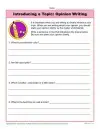
Students, especially beginning writers, sometimes have trouble getting started. This activity helps them learn how to introduce topics.
Introducing a Topic: Telling a Story
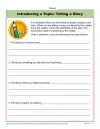
This activity helps students learn how to clearly introduce a topic in a story they are telling. In this activity, students will write the setting of the story.
How to Write a Thesis Statement
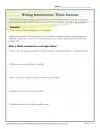
This activity helps students develop a strong thesis statement for their essays by providing practice writing sample statements.
How to Write an Introduction: Bridge Building Activity
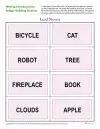
This activity is designed to help students learn about writing introductions through a fun bridge building activity to join the lead noun card and thesis statement card.
How to Write an Introduction: Different Leads
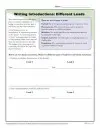
This is a fun, creative activity where students explore ways to include factoids, stories, metaphors and more to create “hooks”. A great activity to help students develop strong introductions.
How to Write an Introduction: Lead Types
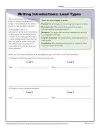
Creating an attention-grabbing lead isn’t always easy but it’s very rewarding to students when they are able to create engaging introductions. This activity provides great practice to build better introductions!
How to Write an Introduction: Lead, Bridge, and Thesis
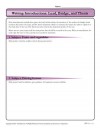
Let’s combine it all! This activity helps students use thesis statements, bridges and leads to write strong essay introductions.
How to Write an Introduction: Write a Complete Introduction
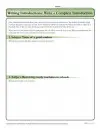
This activity helps students bring together what they’ve learned to write a complete introduction, including the lead, bridge, and thesis statement.
- Search All Scholarships
- Exclusive Scholarships
- Easy Scholarships to Apply For
- No Essay Scholarships
- Scholarships for HS Juniors
- Scholarships for HS Seniors
- Scholarships for College Students
- Scholarships for Grad Students
- Scholarships for Women
- Scholarships for Black Students
- Scholarships
- Student Loans
- College Admissions
- Financial Aid
- Scholarship Winners
- Scholarship Providers

Apply to vetted scholarship programs in one click
Student-centric advice and objective recommendations.
Higher education has never been more confusing or expensive. Our goal is to help you navigate the very big decisions related to higher ed with objective information and expert advice. Each piece of content on the site is original, based on extensive research, and reviewed by multiple editors, including a subject matter expert. This ensures that all of our content is up-to-date, useful, accurate, and thorough.
Our reviews and recommendations are based on extensive research, testing, and feedback. We may receive commission from links on our website, but that doesn’t affect our editors’ opinions. Our marketing partners don’t review, approve or endorse our editorial content. It’s accurate to the best of our knowledge when posted. You can find a complete list of our partners here .
How to Start a Scholarship Essay (With Examples)

Will Geiger is the co-founder of Scholarships360 and has a decade of experience in college admissions and financial aid. He is a former Senior Assistant Director of Admissions at Kenyon College where he personally reviewed 10,000 admissions applications and essays. Will also managed the Kenyon College merit scholarship program and served on the financial aid appeals committee. He has also worked as an Associate Director of College Counseling at a high school in New Haven, Connecticut. Will earned his master’s in education from the University of Pennsylvania and received his undergraduate degree in history from Wake Forest University.
Learn about our editorial policies

Bill Jack has over a decade of experience in college admissions and financial aid. Since 2008, he has worked at Colby College, Wesleyan University, University of Maine at Farmington, and Bates College.

Maria Geiger is Director of Content at Scholarships360. She is a former online educational technology instructor and adjunct writing instructor. In addition to education reform, Maria’s interests include viewpoint diversity, blended/flipped learning, digital communication, and integrating media/web tools into the curriculum to better facilitate student engagement. Maria earned both a B.A. and an M.A. in English Literature from Monmouth University, an M. Ed. in Education from Monmouth University, and a Virtual Online Teaching Certificate (VOLT) from the University of Pennsylvania.

As an admissions officer, I reviewed thousands of essays for students seeking admission and scholarships. The essay is one of the most important parts of the scholarship application process–a strong essay can go a long way. However, with so much competition, it is important for your scholarship essay to stand out. That’s why it’s important for you to start a scholarship essay off right!
There are some very simple things that you can do to ensure that your essay is engaging from the very first sentence. In fact, beginning your essay with an exciting opening is one of the most important things you can do, because it will immediately distinguish your essay from the others.
Keep on reading to learn more about how you can nail the very first sentence and start your essay off right!
Engage the reader with the first sentence
No matter what type of essay you are writing, you will want to ensure that the very first line grabs the attention of the reader. One of the biggest mistakes that students make when starting their essay is simply restating the prompt. This is bland and boring.
Now, you might be wondering, “how do I engage the reader with the very first line of my essay?”. The good news is that there are several ways that you can do this that are very simple to do.
Related: How to answer scholarship essay questions about your career goals
Begin with dialogue
First, you could begin your essay with conversation. This can be an interesting and unexpected way to start your scholarship essay. Maybe someone asked you an unexpected question? Perhaps you were having an interesting conversation with a friend or family member? Either way, dialogue can be a powerful tool to start your essay.
Apply to these scholarships due soon

$10,000 “No Essay” Scholarship

$2,000 Sallie Mae Scholarship

“Mom to Scholar” Scholarship for Mothers

Niche $25,000 “No Essay” Scholarship

“Gutsy Graduate Student” Essay Scholarship

$25k “Be Bold” No-Essay Scholarship

“College Here I Come” Essay Scholarship for High School Seniors

“Making Waves” Scholarship for Women

$10,000 CollegeXpress Scholarship
Put the reader in your shoes.
Alternatively, you can choose to start your essay by placing the reader right in your shoes and show them something from your life. Appeal to the senses and show the reader what you see, hear, smell, or taste. These specific details will help your essay come to life and make it even more memorable.
Also recommended: What’s the best scholarship essay format?
Scholarship essay introduction example
Next, we’ll look at a specific example of how you can open up your essay. Let’s say you are applying for the Questbridge scholarship program . One of the essays that you will be asked is:
We are interested in learning more about you and the context in which you have grown up, formed your aspirations, and accomplished your academic successes. Please describe the factors and challenges that have most influenced you. How are they shaping your future aspirations?
You might be tempted to rephrase the question and start your essay with something like:
“I have grown up in a rural context and this has formed my aspirations and allowed me to accomplish academic success…”
This is generic and will not engage your reader at all.
Instead, what if you started off your essay with something like this:
“I look outside my bedroom window and see Henry, my favorite chicken, pecking at something in the dirt.”
Makes a big difference, right? As a reader, you are probably wondering: why does this person have chickens outside their bedroom window? Why did they name this particular chicken Henry?
See also: Here are our top writing & essay scholarships for students!
Keep the ending of your essay in mind as you write the opening
While crafting your opening, be open to ideas about how to close your essay. There is no need to stress about the ending now, but being mindful of effective ways to end an essay is always a good idea. Say you are opening your scholarship essay with Henry the chicken. Is there a way for Henry to make an impactful appearance at the end of the essay to close things out in a way that perfectly wraps everything up? The key is for the essay ending to be meaningful and memorable for the reader.
Don’t miss: Our free scholarship search tool
If you can’t think of a “wow” scholarship essay beginning, keep writing!
Sometimes, we know what we want to say, point by point, but we are not ready to be creative when it comes to opening an essay. In that case, keep writing! There is always the option of going back and crafting an engaging opening after your essay is written. Simply write your main idea where the first paragraph would be to guide you as you write. After, go back when your creative juices are flowing, and craft the amazing opening (and closing) that your scholarship essay deserves!
Final thoughts
As shown, there are many questions that we as readers will have after reading an engaging essay opening such as the one just shared; We want to learn more about the student who is writing this essay. After all, as a writer trying to stand out in a pile of essays, that is our main goal.
We hope that you have a better understanding of how to start a scholarship essay so you can maximize your chances of winning scholarships!
Additional resources
Scholarships360 is the go-to for all things college admissions and scholarships! Wondering how to write a 250 word essay and how to write a 500 word essay ? Curious how to write an essay about yourself ? Wow, do we have the resources to help! Additionally, check out our free scholarship search tool to help you finance your college education. Best of luck to you and your future endeavors!
Key Takeaways
- The first sentence of the essay is what makes the reader want to continue reading
- Engage the reader by appealing to the senses
- Create a sense of wonder in your essay, making the reader want to learn more about you
- Keep the ending of the essay in mind as you craft the beginning
Frequently asked questions about how to start a scholarship essay
What is an essay hook, how long should my scholarship essay be, scholarships360 recommended.

Top 63 No Essay Scholarships in March 2024

Top 247 Scholarships for High School Juniors in March 2024

$20k in Exclusive Scholarships from Scholarships360
Trending now.

Top 47 Easy Scholarships✅ to Apply For in March 2024

Top 1,272 Scholarships for High School Seniors in March 2024

Top Scholarships for Current College Students in March 2024
3 reasons to join scholarships360.
- Automatic entry to our $10,000 No-Essay Scholarship
- Personalized matching to thousands of vetted scholarships
- Quick apply for scholarships exclusive to our platform
By the way...Scholarships360 is 100% free!
Bulk Content Generator
Brand Voice
AI Text Editor
Introduction Generator
Generate compelling introductions for your articles, essays, novels, and more.
AI-powered Introduction Generator
Looking for a tool that can help you generate an entire article that is coherent and contextually relevant? Try our Blog Post Generator to create ready-to-publish content that are already optimized for maximum clarity and engagement.

Your generated introduction will appear here.

Introduction
An Introduction Generator is a groundbreaking tool that helps writers in various fields - from blog posts and essays to novels and business proposals. This AI-powered technology works by creating interesting introductions specifically for your topic with just a click. You simply enter the title or subject of your content, and you'll receive a set of well-crafted introduction paragraphs.
One such powerful tool in this space is Junia AI 's Introduction Generator . Designed with the latest AI-technology, it generates high-quality introductions that not only save time but also elevate the standard of your writing.
The key benefits of using Junia AI's Introduction Generator are:
- Enhanced efficiency
- Improved quality
- Greater engagement with readers
- Increased creativity
- Boost in content traffic
The Role of Introductions in Different Types of Content
Introductions are like the front door of your content – they welcome readers in. Whether you're writing an essay, a blog post , a novel, or a business proposal, the introduction plays a crucial role in setting the tone and capturing attention.
Here's how introductions work in different types of content:
1. Essay Introductions
In essays, the introduction is where you present your main argument or thesis. It's also an opportunity to grab readers' interest with a thought-provoking question or a bold statement.
For example:
"As sea levels rise and Arctic ice melts, the evidence of global warming can no longer be ignored."
2. Blog Introductions
Blogs are all about personality and relevance. A good blog introduction often starts with a relatable story or anecdote to hook readers right from the beginning.
Here's an example:
"The moment my feet touched the cobblestone streets of Rome, I knew my adventure had truly begun."
By sharing personal experiences, you can create a connection with your audience and makes them eager to read more about your travels.
3. Novel Openings
In novels, the opening lines are like a sneak peek into the world you've created. They should spark curiosity and make readers curious about what comes next.
Here's how 'The Last Sunset' starts:
"Amelia stood at the edge of civilization, the vast desert stretching before her like an unturned page."
With this vivid description, the author paints a picture in the reader's mind and leaves them wanting to know more about Amelia and her journey.
4. Business Proposal Introductions
Business proposals need to make a strong impression right from the start. An effective introduction in this context should establish your credibility and highlight the value you can offer.
For instance:
"In today's competitive market, ABC Corp’s innovative approach to digital marketing stands out as a beacon of efficiency."
This introduction immediately grabs the attention of potential clients by addressing a pressing need or opportunity they may have.
5. Academic Research Introductions
In academic research papers, the introduction serves as a roadmap for the study. It outlines the research questions and hypotheses, providing clarity on what the paper aims to achieve.
Here's an example of how an academic introduction could begin:
"This study examines the underexplored impact of social media on language acquisition among teenagers."
By stating the specific focus of the research, the introduction sets clear expectations for readers and highlights the significance of the study.
Each example shows how introductions are tailored to different types of content, making them relevant and enticing enough to keep readers engaged.
AI-Powered Natural Language Processing: The Secret Sauce Behind High-Quality Introductions
Artificial Intelligence (AI) is the foundation of modern introduction generators like Junia AI. One of the main AI technologies driving these tools is Natural Language Processing (NLP). NLP enables software to comprehend, analyze, and produce human language in a meaningful way . It's what enables an Introduction Generator to generate introductions that are relevant to the context and interesting to readers.
How NLP Works in an Introduction Generator
When you enter your title or topic into an Introduction Generator, the NLP technology goes to work. It examines the input, grasps its meaning, and generates an introduction that fits the topic. This ensures that your introductions are not just generic paragraphs but tailored pieces designed to capture your reader’s interest right from the start.
Continuous Improvement with Machine Learning
Another layer of complexity comes with Machine Learning (ML), another part of AI. With ML algorithms, introduction generators go beyond content creation; they learn from it. These algorithms identify patterns and constantly enhance the quality of generated introductions based on real-time feedback. This means that over time, these tools become better at creating high-quality introductions that are customized to your specific requirements.
In essence, it's this combination of AI’s Natural Language Processing and Machine Learning capabilities that make introduction generators such invaluable tools for content creators. They don't just save time; they elevate the quality of your written work by ensuring each piece begins with a compelling introduction.
Advantages of Using an Introduction Generator like Junia AI
When you use an Introduction Generator like Junia AI, it offers more than just convenience. Here are the main benefits that can improve your writing process:
- Time Efficiency : As a writer or content creator, every minute counts. Junia AI's Introduction Generator quickly creates introductions, saving you valuable time. This allows you to focus more on researching, writing, and improving the main content, which is crucial for depth and detail.
- Improved Quality and Professionalism : An introduction is a crucial part that sets the tone for your entire piece. Junia AI makes sure this first impression is polished and professional. The introductions generated are not only interesting but also customized to match the quality you aim for in your writing.
- Higher Reader Engagement : The right opening can grab your audience's attention right away. With well-written openings provided by Junia AI, readers are more likely to stay interested in your content, leading to better retention rates and overall satisfaction.
- Boosted Creativity and Idea Generation : Sometimes, starting is the most difficult part. Junia AI acts as a partner in brainstorming, giving you a base on which ideas can develop. It sparks creativity by suggesting different angles and perspectives you might not have thought of before.
By incorporating these benefits into your workflow, Junia AI's Introduction Generator becomes more than just a tool; it's a collaborator that improves the quality of your content while making your creative process smoother.
Tips for Using Introduction Generators Effectively
Using an Introduction Generator can be a game-changer in your content creation process, but it's crucial to use these tools effectively to get the most out of them.
1. Customize the Output
The first rule of thumb is to treat the output from an introduction generator as a starting point for customization . Don't see it as the final product. These tools are meant to give you a strong foundation that you can then modify and adapt to your own style and the specific needs of your audience. Remember, automated tools can't fully replicate human creativity and nuanced understanding of context, so adding your personal touch is essential .
2. Review and Edit Carefully
To ensure consistency with the rest of your content, take an active role in proofreading and editing the generated introductions. Pay attention to:
- Consistency in tone and style throughout the text.
- Relevance and alignment with the main body of content.
- Clarity of message and avoidance of ambiguity.
- Readability - read the introduction aloud to assess its flow and readability. Make any necessary adjustments to enhance the overall coherence and impact.
By doing this, you can maintain a smooth flow of information and keep your readers interested from start to finish.
Incorporating these practices in your writing routine can help you make the most of introduction generators and improve your content overall.
Choosing the Right Introduction Generator for Your Needs
Selecting the ideal Introduction Generator for your writing projects involves careful consideration of several factors. You need a tool that not only streamlines your workflow but also aligns with your content goals and quality standards. Here are key criteria to evaluate:
1. Accuracy and Relevance
Ensure the generator produces introductions that accurately reflect your topic and resonate with your target audience.
2. Customization Options
Look for tools offering customization features, allowing you to tailor the output to your voice and style preferences.
3. Ease of Use
A user-friendly interface is crucial for a seamless experience. Opt for generators that simplify the creative process with intuitive controls.
4. Output Quality
The best introduction generators provide well-structured, coherent, and engaging content that requires minimal editing.
5. Feedback Incorporation
Choose a generator capable of learning from user feedback, thus improving over time.
6. Support and Resources
Consider whether there's quality customer support and resources like tutorials or community forums.
Given these criteria, Junia AI's Introduction Generator stands out as a top choice for writers. It is renowned for its:
- High-quality output that often surpasses expectations
- Advanced AI technology ensuring relevance and coherence
- Positive user reviews attesting to its effectiveness
- Robust feature set catering to a diverse range of writing needs
Writers seeking an edge in crafting compelling introductions will find Junia AI to be an invaluable asset in their toolkit.
Using AI technology like Junia AI's Introduction Generator can greatly enhance your ability to create effective introductions. Here's why it's worth considering:
- Efficiency : These tools make writing introductions faster and easier.
- Quality : With machine learning algorithms, the intros you generate will continuously improve, sounding more professional and polished.
- Engagement : Well-crafted introductions grab readers' attention and make them more likely to continue reading.
By using Junia AI's Introduction Generator, you can experience these benefits for yourself. This tool demonstrates how AI can transform the writing process, providing a valuable resource for writers who want to captivate their audience from the very beginning.
Give it a try and discover how AI can revolutionize your approach to writing!
Frequently asked questions
- What is an Introduction Generator? An Introduction Generator is a groundbreaking tool that helps in creating engaging and impactful introductions for various types of content using AI technology.
- What is the role of introductions in different types of content? Introductions serve as the front door of your content, setting the tone and capturing the audience's attention. They are essential for essays, blogs, novels, business proposals, academic research papers, and more.
- How does an AI Introduction Generator work? An AI Introduction Generator works by using Natural Language Processing (NLP) and Machine Learning (ML) technologies to analyze the input, understand its meaning, and generate contextually relevant and engaging introductions for various types of content.
- What are some reasons to choose Junia AI's AI Introduction Generator? Junia AI's AI Introduction Generator offers time efficiency, improved quality and professionalism, higher reader engagement, and boosted creativity and idea generation. It is a valuable tool for content creators looking to enhance their writing process.
WELCOME TO THE FAMILY! Please check your email for confirmation from us.
Sob stories? Trauma dumps? Black kids worry about writing college essays after affirmative action ban
When the Supreme Court ended affirmative action in higher education, it left the college essay as one of few places where race can play a role in admissions decisions.
- Share on Facebook
- Share on Twitter
- Share via Email
- Copy Link Link Copied
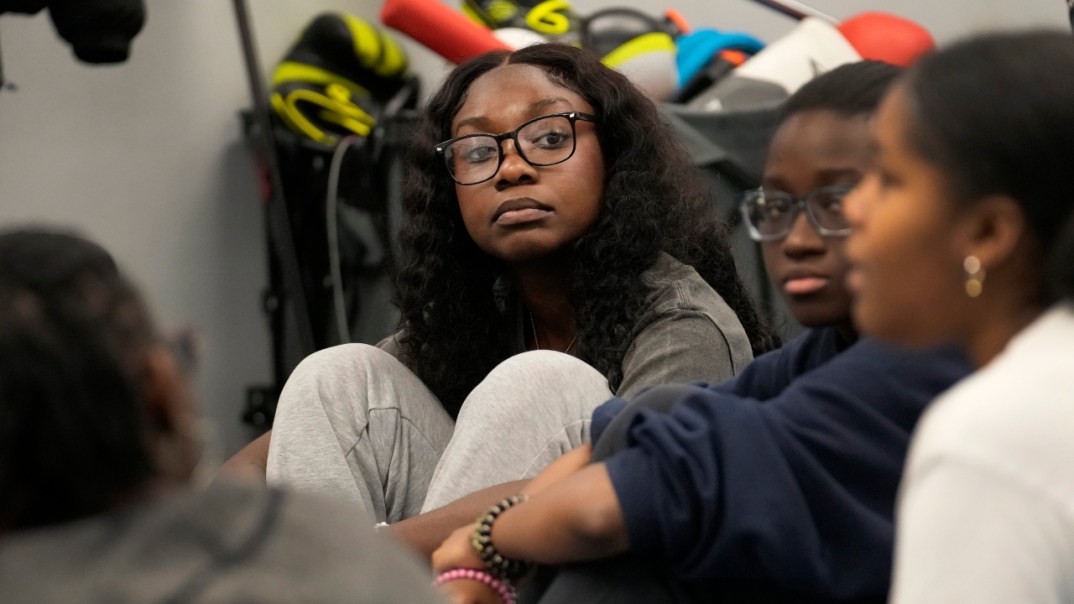
CHICAGO (AP) — When she started writing her college essay, Hillary Amofa told the story she thought admissions offices wanted to hear. About being the daughter of immigrants from Ghana and growing up in a small apartment in Chicago. About hardship and struggle.
Then she deleted it all.
“I would just find myself kind of trauma-dumping,” said the 18-year-old senior at Lincoln Park High School in Chicago. “And I’m just like, this doesn’t really say anything about me as a person.”
When the Supreme Court ended affirmative action in higher education , it left the college essay as one of few places where race can play a role in admissions decisions. For many students of color, instantly more was riding on the already high-stakes writing assignment. Some say they felt pressure to exploit their hardships as they competed for a spot on campus.
Amofa was just starting to think about her essay when the court issued its decision, and it left her with a wave of questions. Could she still write about her race? Could she be penalized for it? She wanted to tell colleges about her heritage but she didn’t want to be defined by it.
In English class, Amofa and her classmates read sample essays that all seemed to focus on some trauma or hardship. It left her with the impression she had to write about her life’s hardest moments to show how far she’d come. But she and some of her classmates wondered if their lives had been hard enough to catch the attention of admissions offices.
“For a lot of students, there’s a feeling of, like, having to go through something so horrible to feel worthy of going to school, which is kind of sad,” said Amofa, the daughter of a hospital technician and an Uber driver.
This year’s senior class is the first in decades to navigate college admissions without affirmative action. The Supreme Court upheld the practice in decisions going back to the 1970s, but this court’s conservative supermajority found it is unconstitutional for colleges to give students extra weight because of their race alone.
Still, the decision left room for race to play an indirect role: Chief Justice John Roberts wrote universities can still consider how an applicant’s life was shaped by their race, “so long as that discussion is concretely tied to a quality of character or unique ability.”
“A benefit to a student who overcame racial discrimination, for example, must be tied to that student’s courage and determination,” he wrote.
Scores of colleges responded with new essay prompts asking about students’ backgrounds. Brown University asked applicants how “an aspect of your growing up has inspired or challenged you.” Rice University asked students how their perspectives were shaped by their “background, experiences, upbringing, and/or racial identity.”
Wondering if schools ‘expect a sob story’
When Darrian Merritt started writing his essay, he knew the stakes were higher than ever because of the court’s decision. His first instinct was to write about events that led to him going to live with his grandmother as a child.
Those were painful memories, but he thought they might play well at schools like Yale, Stanford and Vanderbilt.
“I feel like the admissions committee might expect a sob story or a tragic story,” said Merritt, a senior in Cleveland. “And if you don’t provide that, then maybe they’re not going to feel like you went through enough to deserve having a spot at the university. I wrestled with that a lot.”
He wrote drafts focusing on his childhood, but it never amounted to more than a collection of memories. Eventually he abandoned the idea and aimed for an essay that would stand out for its positivity.
Merritt wrote about a summer camp where he started to feel more comfortable in his own skin. He described embracing his personality and defying his tendency to please others. The essay had humor — it centered on a water gun fight where he had victory in sight but, in a comedic twist, slipped and fell. But the essay also reflects on his feelings of not being “Black enough” and getting made fun of for listening to “white people music.”
“I was like, ‘OK, I’m going to write this for me, and we’re just going to see how it goes,’” he said. “It just felt real, and it felt like an honest story.”
The essay describes a breakthrough as he learned “to take ownership of myself and my future by sharing my true personality with the people I encounter. … I realized that the first chapter of my own story had just been written.”
A ruling prompts pivots on essay topics
Like many students, Max Decker of Portland, Oregon, had drafted a college essay on one topic, only to change direction after the Supreme Court ruling in June.
Decker initially wrote about his love for video games. In a childhood surrounded by constant change, navigating his parents’ divorce, the games he took from place to place on his Nintendo DS were a source of comfort.
But the essay he submitted to colleges focused on the community he found through Word is Bond, a leadership group for young Black men in Portland.
As the only biracial, Jewish kid with divorced parents in a predominantly white, Christian community, Decker wrote he constantly felt like the odd one out. On a trip with Word is Bond to Capitol Hill, he and friends who looked just like him shook hands with lawmakers. The experience, he wrote, changed how he saw himself.
Recommended Stories

Ahmaud Arbery’s killers seeking to overturn their hate crime convictions
Associated Press

High school teacher and students sue over Arkansas’ ban on critical race theory

House Republicans aim to strip funding from medical schools over diversity programs
Ashlee Banks

DEI programs and concepts that could make someone feel guilty about their race banned in Alabama

America’s youngest teacher is a 16-year-old MBA student
TheGrio Lifestyle

MF Doom and Madlib’s ‘Madvillainy’ — now 20 years old — is the timeless classic album we all thought it would be in 2004
Panama Jackson

Before heading ‘outside,’ spring-clean your finances in 4 steps
Jennifer Streaks
“It’s because I’m different that I provide something precious to the world, not the other way around,” he wrote.
As a first-generation college student, Decker thought about the subtle ways his peers seemed to know more about navigating the admissions process. They made sure to get into advanced classes at the start of high school, and they knew how to secure glowing letters of recommendation.
If writing about race would give him a slight edge and show admissions officers a fuller picture of his achievements, he wanted to take that small advantage.
His first memory about race, Decker said, was when he went to get a haircut in elementary school and the barber made rude comments about his curly hair. Until recently, the insecurity that moment created led him to keep his hair buzzed short.
Through Word is Bond, Decker said he found a space to explore his identity as a Black man. It was one of the first times he was surrounded by Black peers and saw Black role models. It filled him with a sense of pride in his identity. No more buzzcut.
The pressure to write about race involved a tradeoff with other important things in his life, Decker said. That included his passion for journalism, like the piece he wrote on efforts to revive a once-thriving Black neighborhood in Portland. In the end, he squeezed in 100 characters about his journalism under the application’s activities section.
“My final essay, it felt true to myself. But the difference between that and my other essay was the fact that it wasn’t the truth that I necessarily wanted to share,” said Decker, whose top college choice is Tulane, in New Orleans, because of the region’s diversity. “It felt like I just had to limit the truth I was sharing to what I feel like the world is expecting of me.”
Spelling out the impact of race
Before the Supreme Court ruling, it seemed a given to Imani Laird that colleges would consider the ways that race had touched her life. But now, she felt like she had to spell it out.
As she started her essay, she reflected on how she had faced bias or felt overlooked as a Black student in predominantly white spaces.
There was the year in math class when the teacher kept calling her by the name of another Black student. There were the comments that she’d have an easier time getting into college because she was Black.
“I didn’t have it easier because of my race,” said Laird, a senior at Newton South High School in the Boston suburbs who was accepted at Wellesley and Howard University , and is waiting to hear from several Ivy League colleges. “I had stuff I had to overcome.”

In her final essays, she wrote about her grandfather, who served in the military but was denied access to GI Bill benefits because of his race.
She described how discrimination fueled her ambition to excel and pursue a career in public policy.
“So, I never settled for mediocrity,” she wrote. “Regardless of the subject, my goal in class was not just to participate but to excel. Beyond academics, I wanted to excel while remembering what started this motivation in the first place.”
Will schools lose racial diversity?
Amofa used to think affirmative action was only a factor at schools like Harvard and Yale. After the court’s ruling, she was surprised to find that race was taken into account even at some public universities she was applying to.
Now, without affirmative action, she wondered if mostly white schools will become even whiter.
It’s been on her mind as she chooses between Indiana University and the University of Dayton, both of which have relatively few Black students. When she was one of the only Black students in her grade school, she could fall back on her family and Ghanaian friends at church. At college, she worries about loneliness.
“That’s what I’m nervous about,” she said. “Going and just feeling so isolated, even though I’m constantly around people.”
The first drafts of her essay focused on growing up in a low-income family, sharing a bedroom with her brother and grandmother. But it didn’t tell colleges about who she is now, she said.
Her final essay tells how she came to embrace her natural hair. She wrote about going to a mostly white grade school where classmates made jokes about her afro. When her grandmother sent her back with braids or cornrows, they made fun of those too.
Over time, she ignored their insults and found beauty in the styles worn by women in her life. She now runs a business doing braids and other hairstyles in her neighborhood.
“I stopped seeing myself through the lens of the European traditional beauty standards and started seeing myself through the lens that I created,” Amofa wrote.
“Criticism will persist, but it loses its power when you know there’s a crown on your head!”
Never miss a beat: Get our daily stories straight to your inbox with theGrio’s newsletter.
- Share on Facebook Facebook
- Share on Twitter Twitter
- Share via Email Email
- Copy Link Copy Link Link Copied

STREAM FREE MOVIES, LIFESTYLE AND NEWS CONTENT ON OUR NEW APP
Have a language expert improve your writing
Check your paper for plagiarism in 10 minutes, generate your apa citations for free.
- Knowledge Base
- College essay
How to Write a Great College Essay Introduction | Examples
Published on October 4, 2021 by Meredith Testa . Revised on August 14, 2023 by Kirsten Courault.
Admissions officers read thousands of essays each application season, and they may devote as little as five minutes to reviewing a student’s entire application. That means it’s critical to have a well-structured essay with a compelling introduction. As you write and revise your essay , look for opportunities to make your introduction more engaging.
There’s one golden rule for a great introduction: don’t give too much away . Your reader shouldn’t be able to guess the entire trajectory of the essay after reading the first sentence. A striking or unexpected opening captures the reader’s attention, raises questions, and makes them want to keep reading to the end .
Table of contents
Start with a surprise, start with a vivid, specific image, avoid clichés, other interesting articles, frequently asked questions about college application essays.
A great introduction often has an element of mystery. Consider the following opening statement.
This opener is unexpected, even bizarre—what could this student be getting at? How can you be bad at breathing?
The student goes on to describe her experience with asthma and how it has affected her life. It’s not a strange topic, but the introduction is certainly intriguing. This sentence keeps the admissions officer reading, giving the student more of an opportunity to keep their attention and make her point.
In a sea of essays with standard openings such as “One life-changing experience for me was …” or “I overcame an obstacle when …,” this introduction stands out. The student could have used either of those more generic introductions, but neither would have been as successful.
This type of introduction is a true “hook”—it’s highly attention-grabbing, and the reader has to keep reading to understand.
Prevent plagiarism. Run a free check.
If your topic doesn’t lend itself to such a surprising opener, you can also start with a vivid, specific description.
Many essays focus on a particular experience, and describing one moment from that experience can draw the reader in. You could focus on small details of what you could see and feel, or drop the reader right into the middle of the story with dialogue or action.
Some students choose to write more broadly about themselves and use some sort of object or metaphor as the focus. If that’s the type of essay you’d like to write, you can describe that object in vivid detail, encouraging the reader to imagine it.
Cliché essay introductions express ideas that are stereotypical or generally thought of as conventional wisdom. Ideas like “My family made me who I am today” or “I accomplished my goals through hard work and determination” may genuinely reflect your life experience, but they aren’t unique or particularly insightful.
Unoriginal essay introductions are easily forgotten and don’t demonstrate a high level of creative thinking. A college essay is intended to give insight into the personality and background of an applicant, so a standard, one-size-fits-all introduction may lead admissions officers to think they are dealing with a standard, unremarkable applicant.
Quotes can often fall into the category of cliché essay openers. There are some circumstances in which using a quote might make sense—for example, you could quote an important piece of advice or insight from someone important in your life. But for most essays, quotes aren’t necessary, and they may make your essay seem uninspired.
If you want to know more about academic writing , effective communication , or parts of speech , make sure to check out some of our other articles with explanations and examples.
Academic writing
- Writing process
- Transition words
- Passive voice
- Paraphrasing
Communication
- How to end an email
- Ms, mrs, miss
- How to start an email
- I hope this email finds you well
- Hope you are doing well
Parts of speech
- Personal pronouns
- Conjunctions
The introduction of your college essay is the first thing admissions officers will read and therefore your most important opportunity to stand out. An excellent introduction will keep admissions officers reading, allowing you to tell them what you want them to know.
The key to a strong college essay introduction is not to give too much away. Try to start with a surprising statement or image that raises questions and compels the reader to find out more.
Cliché openers in a college essay introduction are usually general and applicable to many students and situations. Most successful introductions are specific: they only work for the unique essay that follows.
In most cases, quoting other people isn’t a good way to start your college essay . Admissions officers want to hear your thoughts about yourself, and quotes often don’t achieve that. Unless a quote truly adds something important to your essay that it otherwise wouldn’t have, you probably shouldn’t include it.
Cite this Scribbr article
If you want to cite this source, you can copy and paste the citation or click the “Cite this Scribbr article” button to automatically add the citation to our free Citation Generator.
Testa, M. (2023, August 14). How to Write a Great College Essay Introduction | Examples. Scribbr. Retrieved March 28, 2024, from https://www.scribbr.com/college-essay/introduction-college-essay/
Is this article helpful?

Meredith Testa
Other students also liked, college essay format & structure | example outlines, how to end a college admissions essay | 4 winning strategies, what do colleges look for in an essay | examples & tips, unlimited academic ai-proofreading.
✔ Document error-free in 5minutes ✔ Unlimited document corrections ✔ Specialized in correcting academic texts

IMAGES
VIDEO
COMMENTS
Step 1: Hook your reader. Step 2: Give background information. Step 3: Present your thesis statement. Step 4: Map your essay's structure. Step 5: Check and revise. More examples of essay introductions. Other interesting articles. Frequently asked questions about the essay introduction.
High School Essay Format 1. Introduction. Hook: Start with an engaging sentence to capture the reader's interest. This could be a question, a quote, a surprising fact, or a bold statement related to your topic. ... Writing a high school essay if you have the tips on how to do essay effectively. This will give you an edge from your classmates.
1. Hook the readers with a relevant fact, quote, or question for the first sentence. An attention getter draws readers into your essay. Use a shocking statistic or a hypothetical question to get the reader thinking on your subject. Make sure not to use an attention getter unrelated to the topic of your essay.
Be brief; it's recommended that your introduction make up no more than 8 to 9 percent of the entire text (for example, 200 words for a 2500 words essay). Construct a strong thesis statement. Create some intrigue. Make sure there is a clear and smooth transition from your introduction to the body of your piece.
How to Write an Essay Introduction. An essay introduction has four main steps: Hook your reader Provide context Present your thesis statement Map your essay. Hook Your Reader. The first part of your introduction should be the hook. This is where you introduce the reader to the topic of the essay. A great hook should be clear, concise, and catchy.
Intro Paragraph Part 3: The Thesis. The final key part of how to write an intro paragraph is the thesis statement. The thesis statement is the backbone of your introduction: it conveys your argument or point of view on your topic in a clear, concise, and compelling way. The thesis is usually the last sentence of your intro paragraph.
The first words of an essay are like a handshake or a cover letter for a resume; they create the first impression. If they are strong, confident, and jovial, then you are setting yourself up for success. If they put forward the metaphorical "dead-fish" hand, then your work has been deeply injured, even if what follows is top-notch work.
Let's analyze their meaning and features. 1. Essay hook. It is the best starter for your introduction, focused on grabbing the audience's attention. A good hook always consists of a single sentence and may include an impressive fact relevant to the topic, quote, question, anecdote, or summary.
to teach the subject of their essays or suitably familiar enough with the subject area to provide adequate supervision and advisement over the course of the research and writing process. The essays are graded by examiners appointed by the Chief Examiner of each subject in the IB Office in Cardiff, Wales. Class of 2021 Extended Essay Due Dates
Essential Parts of the High School Essay. You should divide your essay into three main paragraphs: an introduction, body, and conclusion. Provide a brief overview of the topic in the introduction. Here, you also mention the statement that you are going to develop through the entire essay. The essay body is the main part where you give some ...
Step 4: Write the Thesis Statement. The last part of the introduction is the thesis statement. The thesis statement is the central point or argument of your essay. It conveys the main idea you will explore and defend in the following paragraphs.
Most people do not know how to start a high school essay and these tips will be of help when writing the introduction for a high school essay: Have a clear, simple topic that is catchy; Introduce your argument in short sentences; Make a good first impression through your writing style; Be creative e.g. introduce with a provocative question;
The basic structure of an essay always consists of an introduction, a body, and a conclusion. But for many students, the most difficult part of structuring an essay is deciding how to organize information within the body. This article provides useful templates and tips to help you outline your essay, make decisions about your structure, and ...
1. Background sentences. The first two or three sentences of your introduction should provide a general introduction to the historical topic which your essay is about. This is done so that when you state your hypothesis, your reader understands the specific point you are arguing about. Background sentences explain the important historical ...
Part I: The Introduction. An introduction is usually the first paragraph of your academic essay. If you're writing a long essay, you might need 2 or 3 paragraphs to introduce your topic to your reader. A good introduction does 2 things: Gets the reader's attention. You can get a reader's attention by telling a story, providing a statistic ...
For writers, that chance is in the introduction of an essay or text. If a writer can interest and engage a reader immediately, the writer has made a good first impression. Our worksheets on writing an engaging and interesting essay introduction are below. Simple click on the title to view more about the worksheet or to download a PDF.
The first sentence of the essay is what makes the reader want to continue reading. Engage the reader by appealing to the senses. Create a sense of wonder in your essay, making the reader want to learn more about you. Keep the ending of the essay in mind as you craft the beginning.
Whether you're writing an essay, a blog post, a novel, or a business proposal, the introduction plays a crucial role in setting the tone and capturing attention. Here's how introductions work in different types of content: 1. Essay Introductions. In essays, the introduction is where you present your main argument or thesis.
The structure of your expository essay will vary according to the scope of your assignment and the demands of your topic. It's worthwhile to plan out your structure before you start, using an essay outline. A common structure for a short expository essay consists of five paragraphs: An introduction, three body paragraphs, and a conclusion.
You may like. 28 Likes, TikTok video from Uplift Education (@uplifteducationaustralia): "Learn how to write a strong introduction for your HSC Economics essay, including keyword definition, concise answer, argument outline, and linking to contemporary context. Improve your marks now!".
Hillary Amofa listens to other members of the Lincoln Park High School step team after school in Chicago. When she started writing her college essay, Amofa told the story she thought admissions ...
Good example. I wiped the sweat from my head and tried to catch my breath. I was nearly there—just one more back tuck and a strong dismount and I'd have nailed a perfect routine. Some students choose to write more broadly about themselves and use some sort of object or metaphor as the focus.